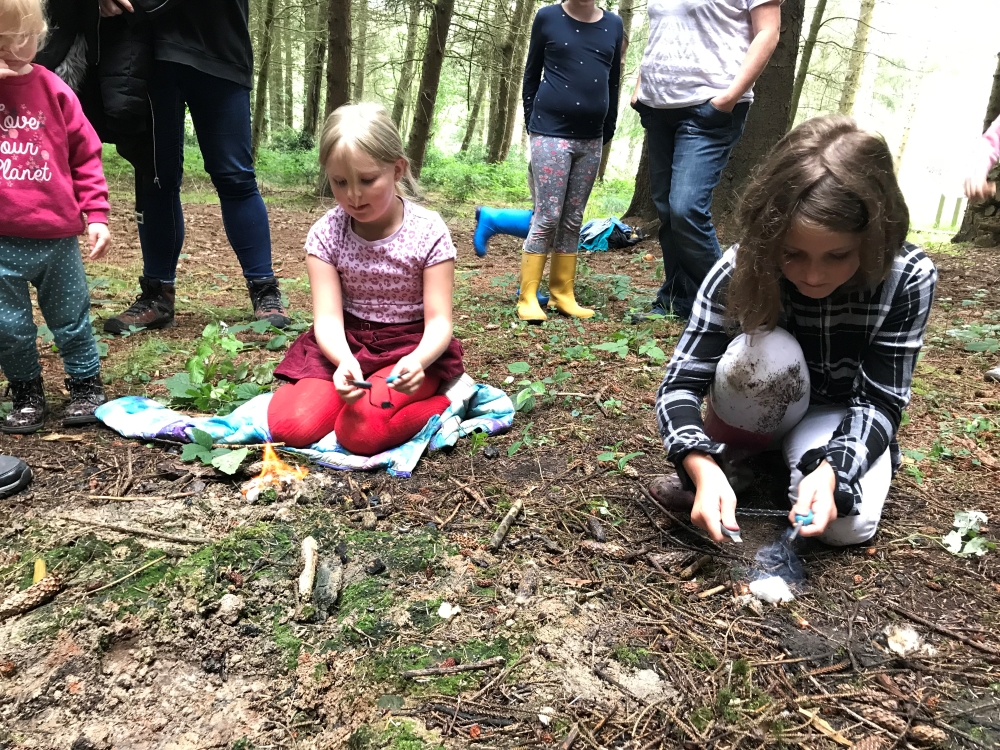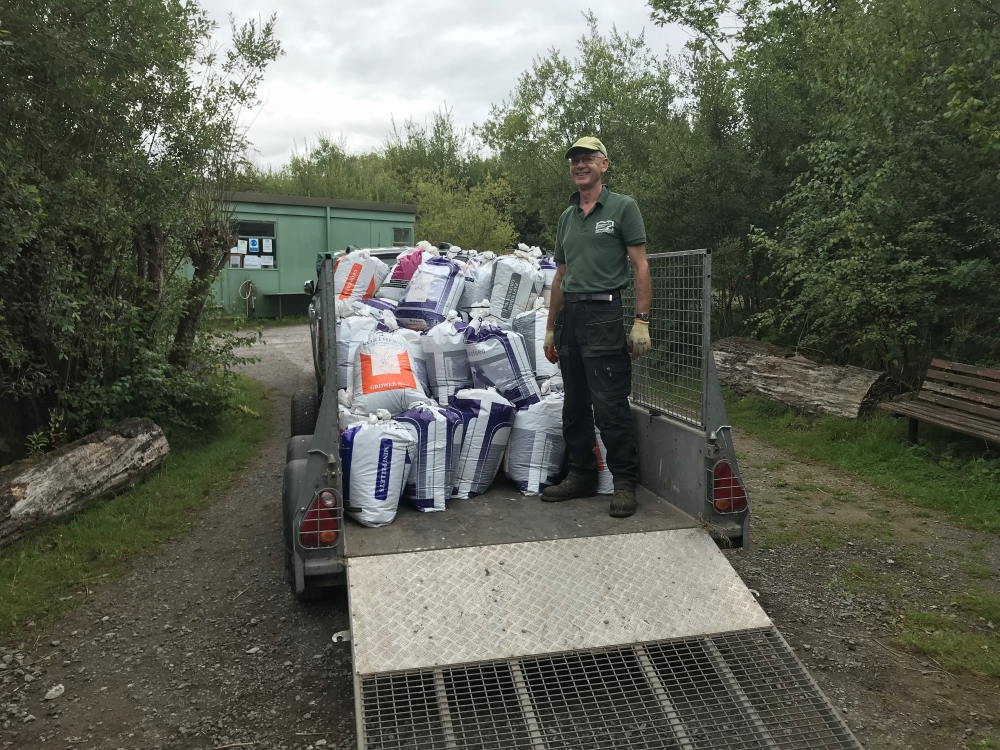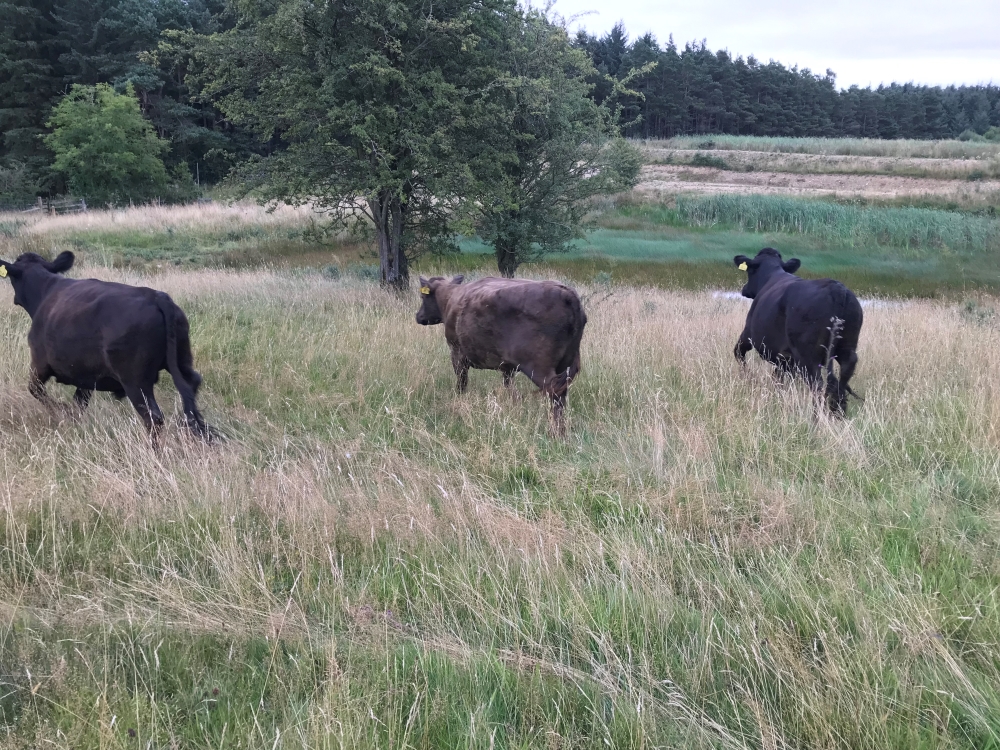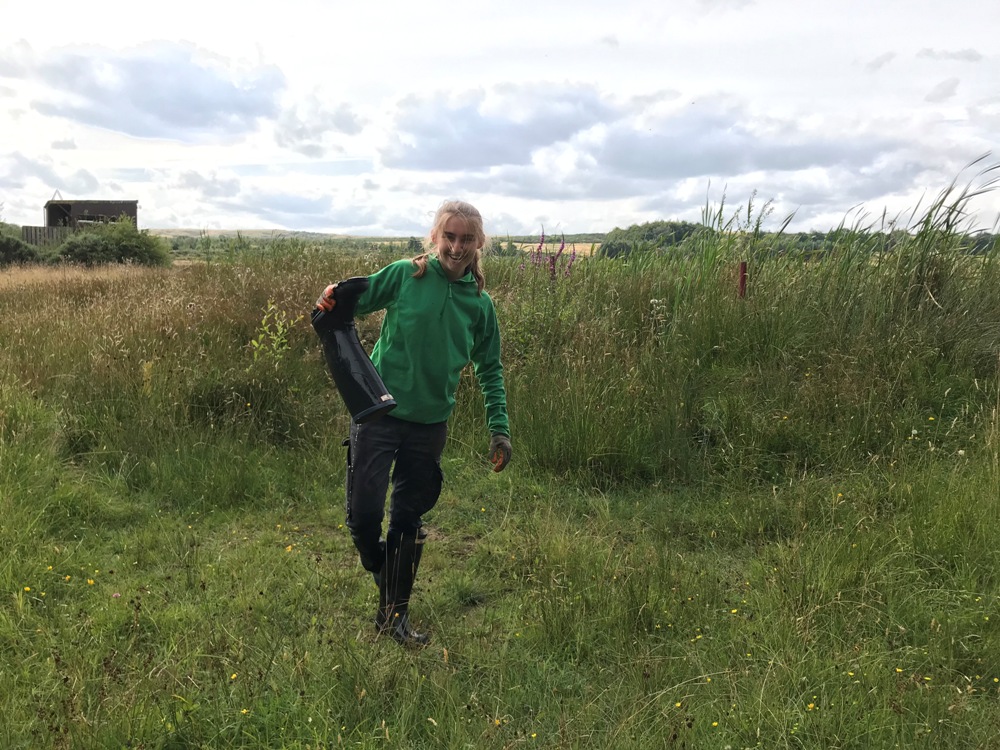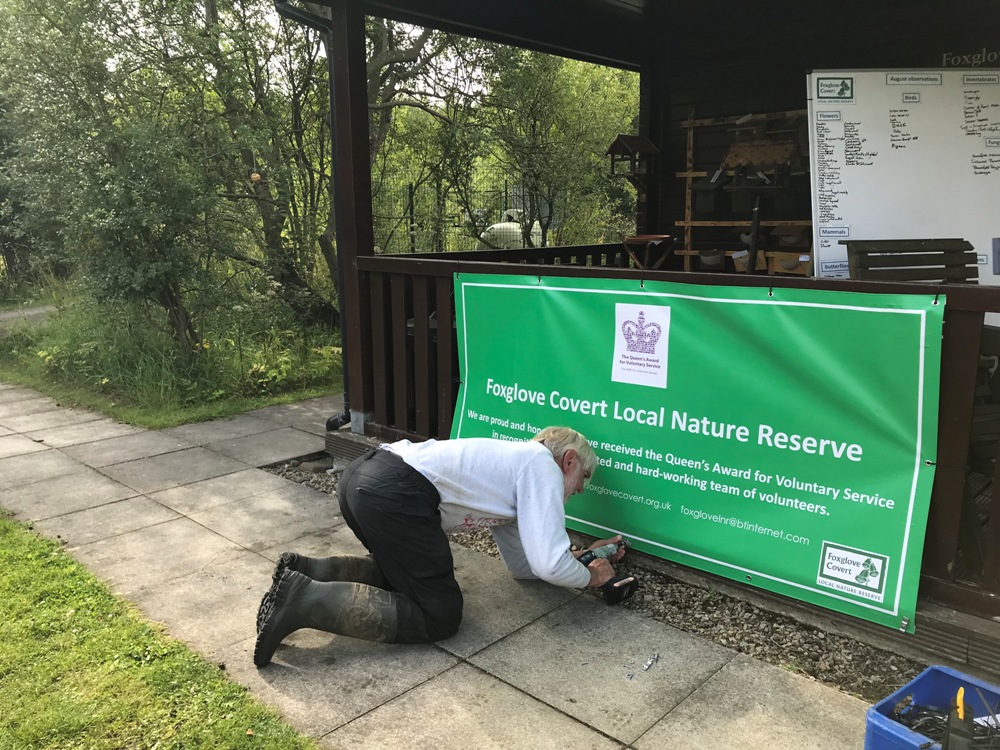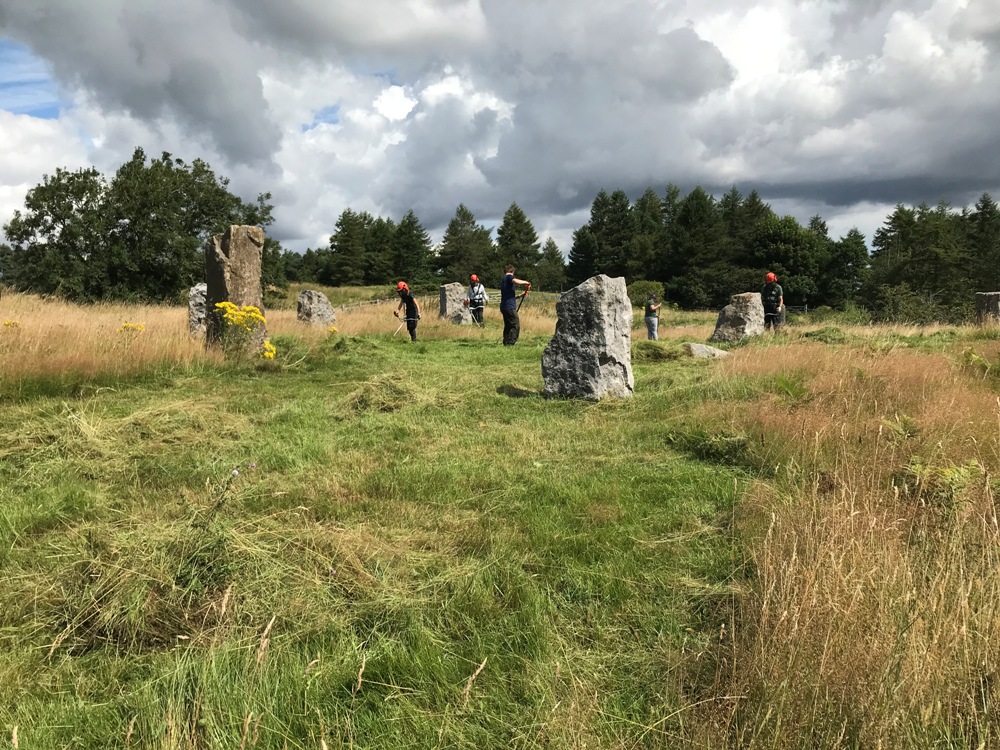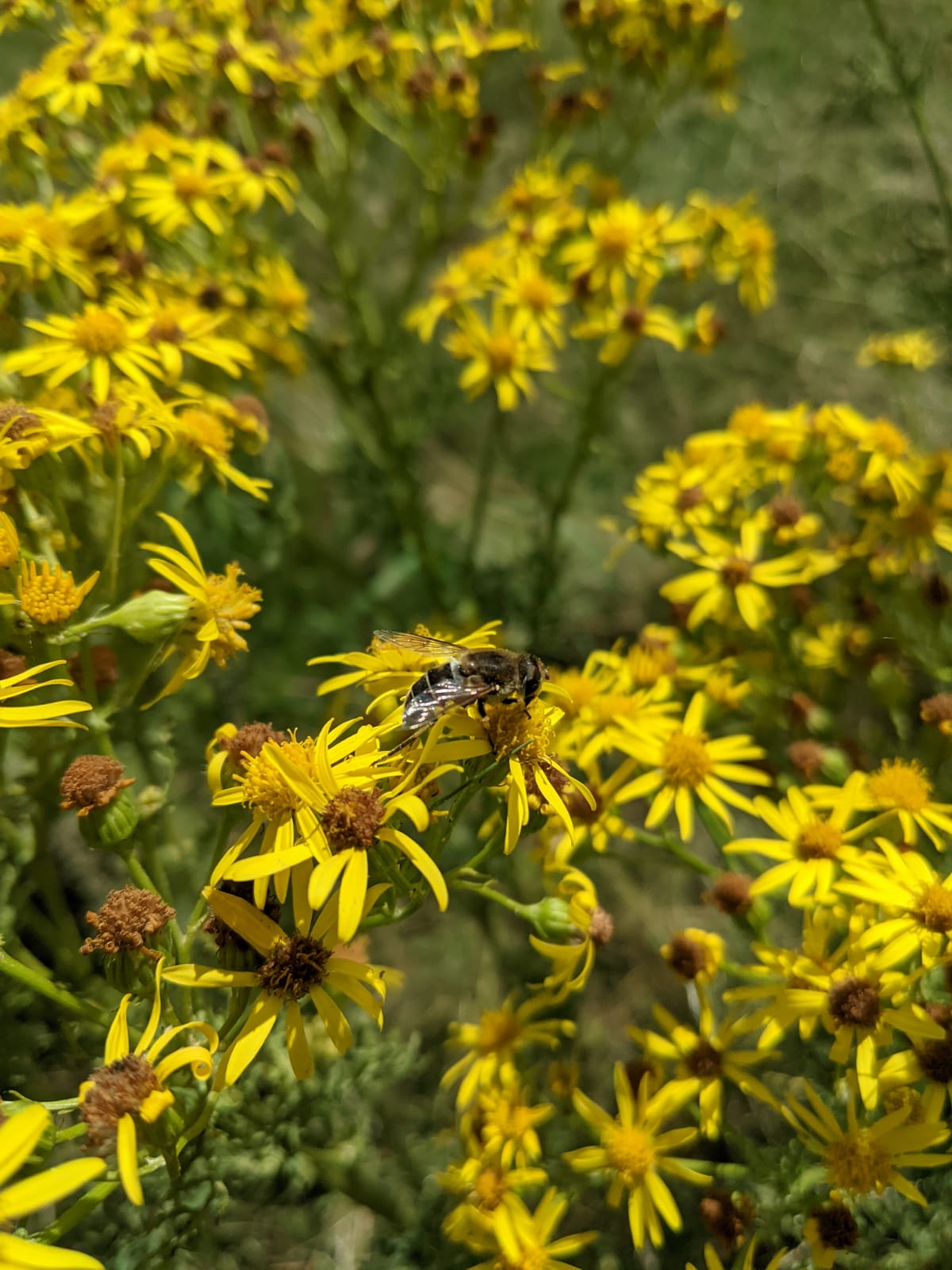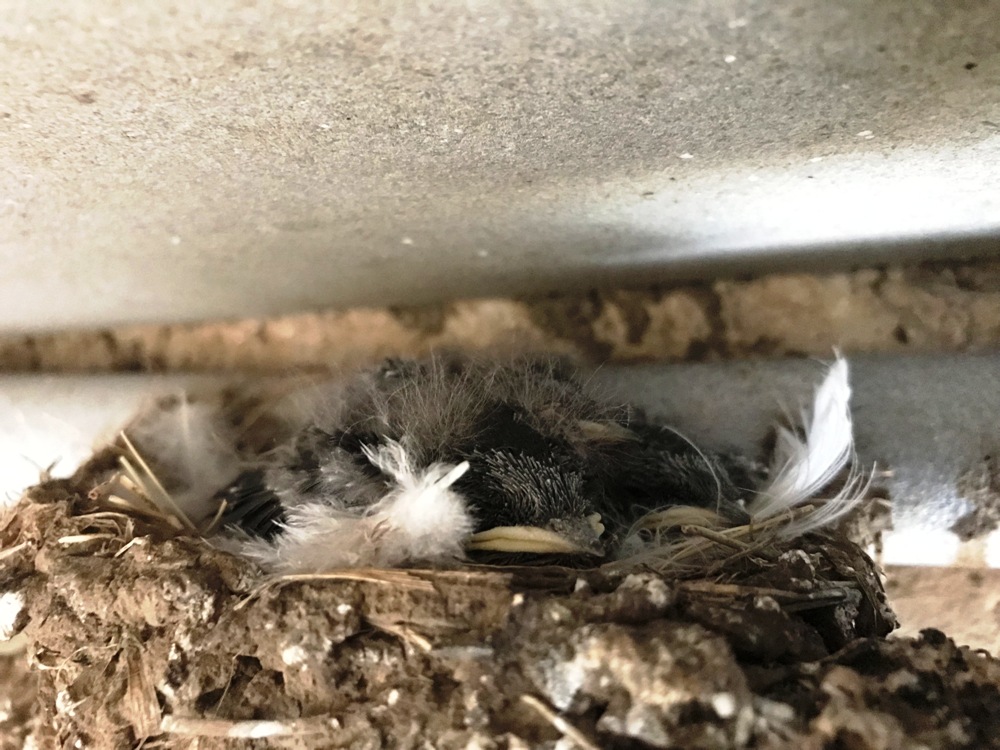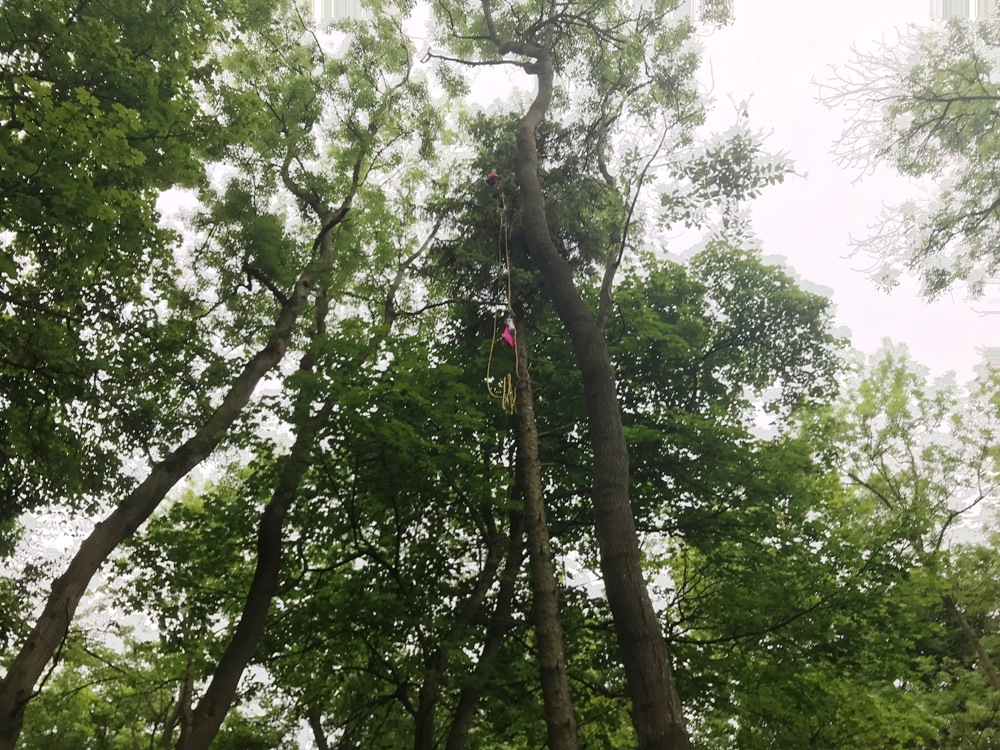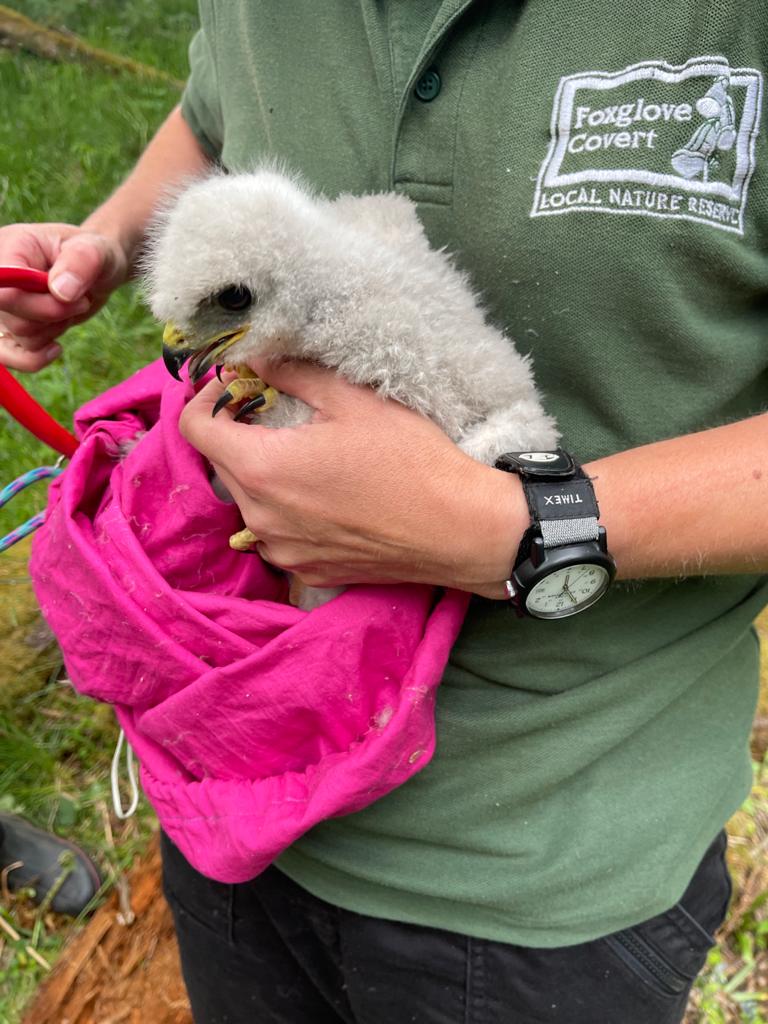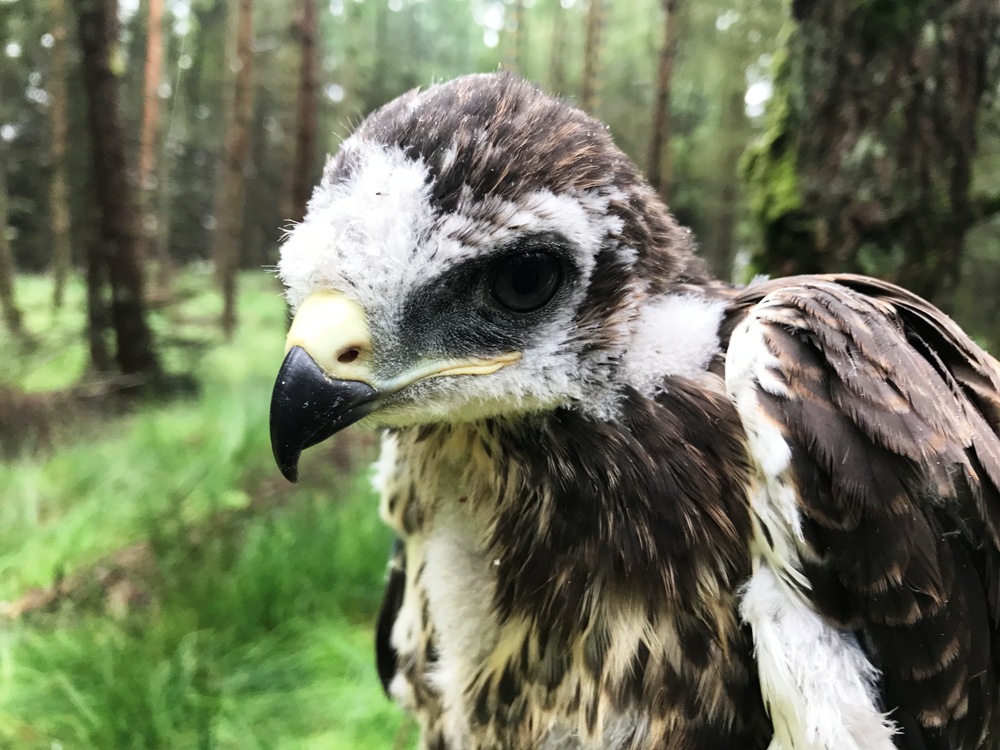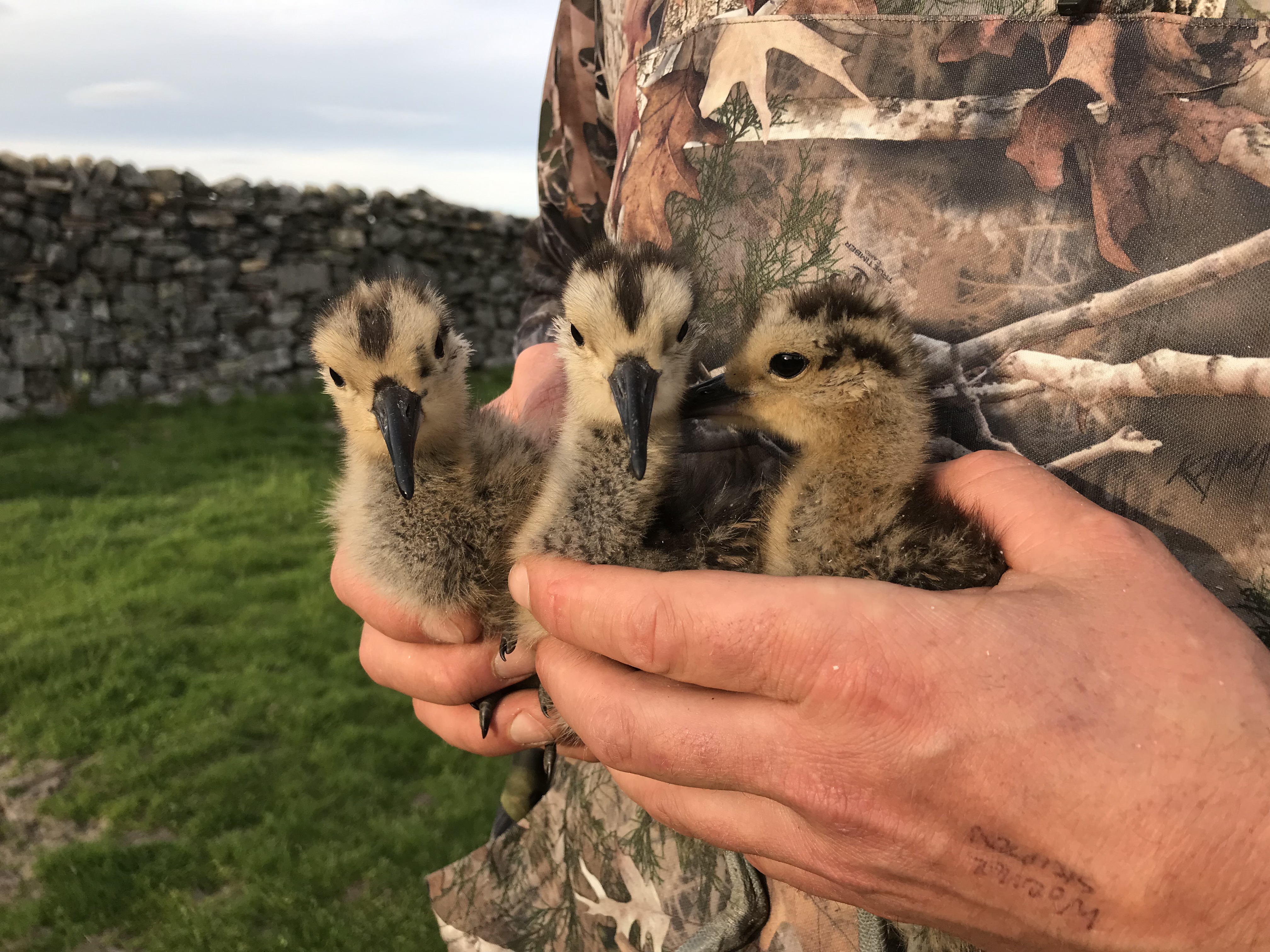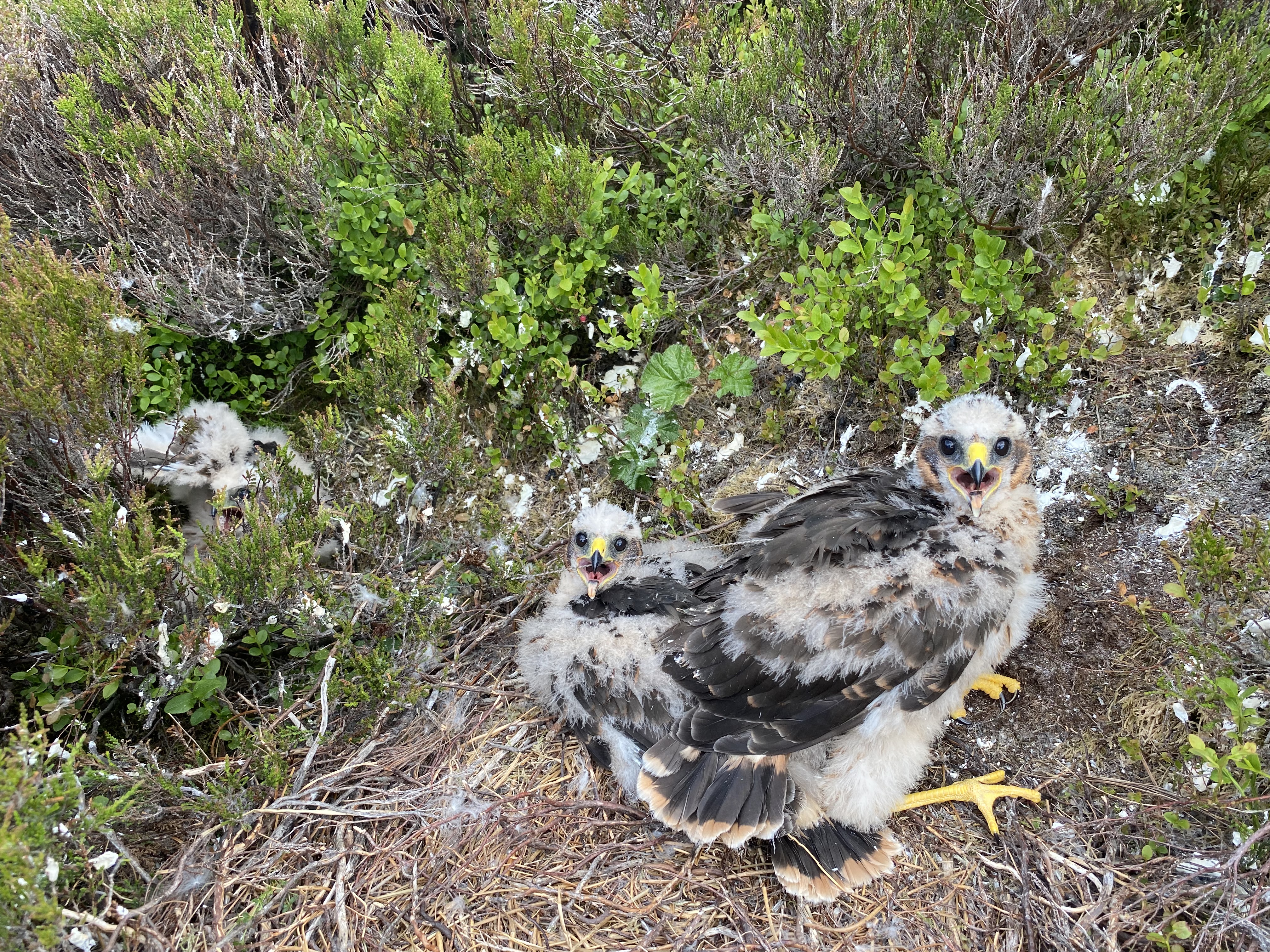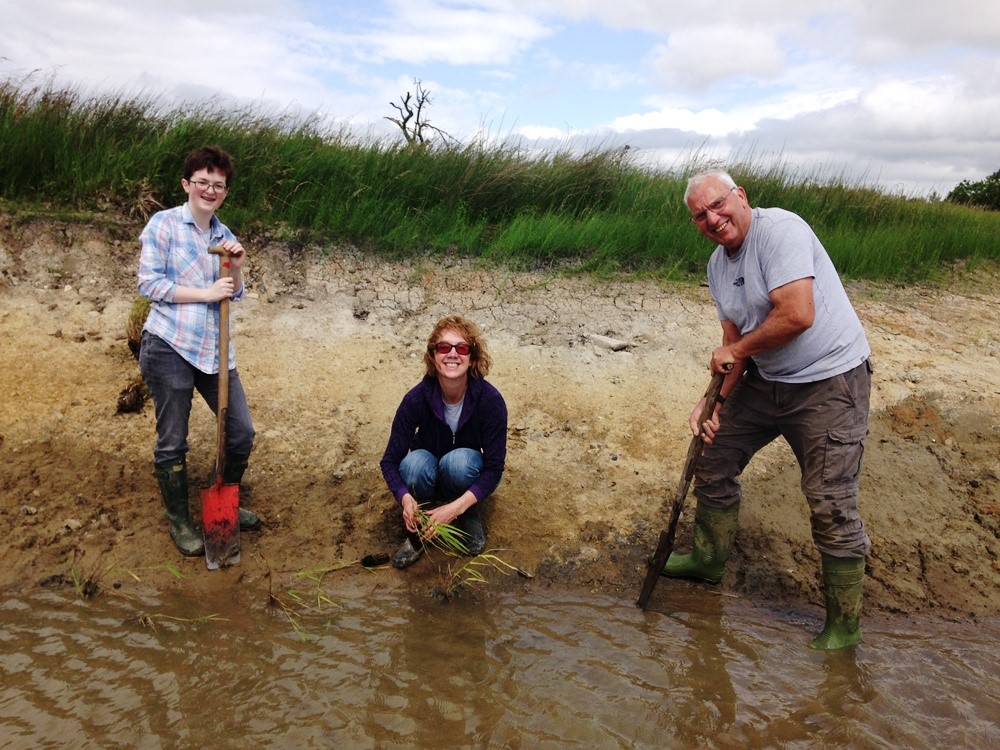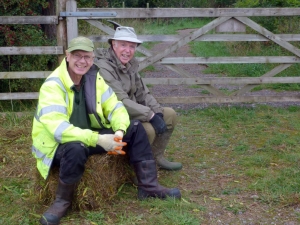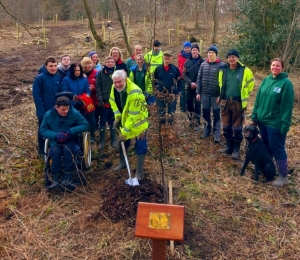Blog Archive (22) Posts Made in August 2021
Bee Happy Day!
Monday, August 30th 2021
Today was a celebration of all things bee at the reserve! There was something for all ages. For the adults a chance to talk to beekeepers from the Richmond & District Beekeepers' Association to learn more about the art of beekeeping.

For younger visitors there were lots of different activities such as making a bee puppet, colouring in, word searches, fact sheets, honey tasting and even making a candle from beeswax. Some of the adults enjoyed these too!
There was also a 'Bee Trail' with several bee clues hidden around the red route. The trail will stay in place for the remainder of the week, if you would like to have a go then pick up a quiz sheet from the Field Centre.
Our sincere thanks to Colonel Alistair and Alison for giving up their day for the event and to Elizabeth for preparing all of the activity sheets and making the 'bee trail'. Thank you too to all of the families who visited today in the 'liquid sunshine'!
Back to Work
Sunday, August 29th 2021
Foxglove volunteers were back at work today, ringing at another site. It was the last chance to ring the summer migrants before they head to their summer homes. A juvenile Sedge Warbler was ringed. These birds cross the Sahara to reach Africa where they spend our winter.
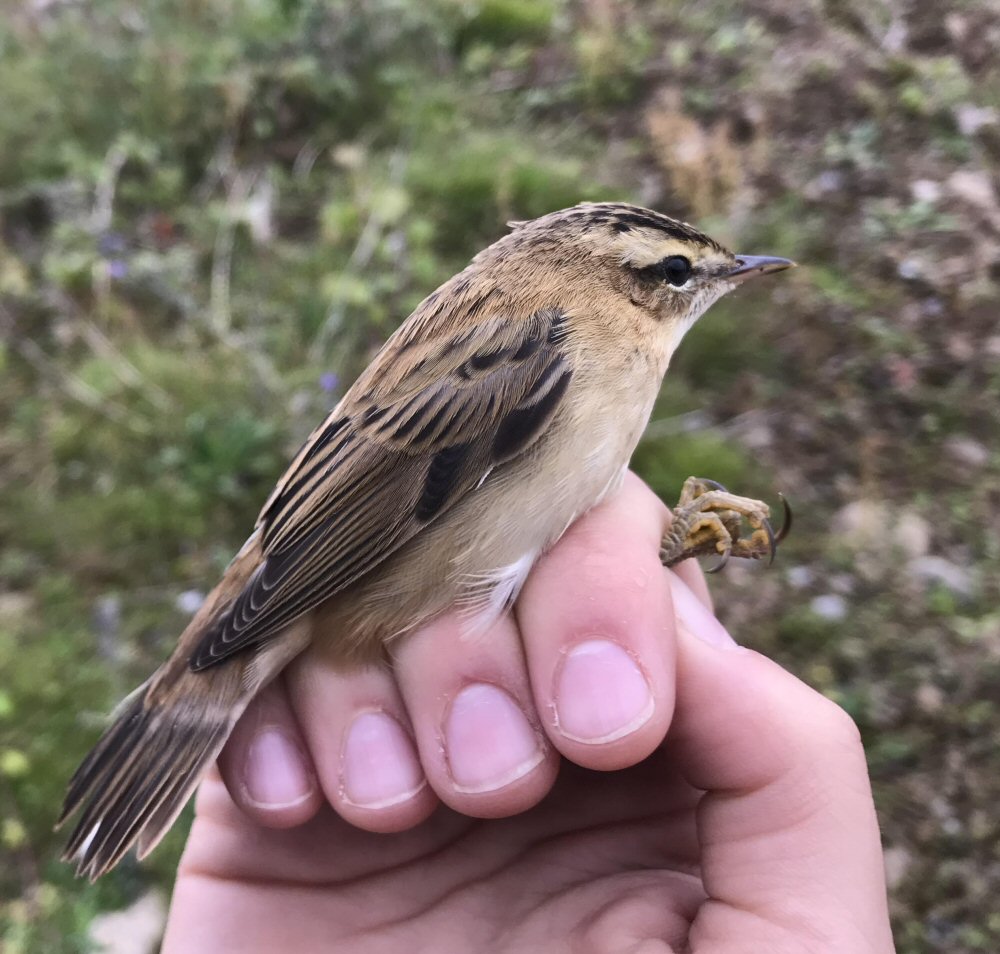
Reed Warblers weave their nests as a sling between two or three reed stems, and lay three to five eggs in it. Forming monogamous pairs, both parents raise the chicks, bringing them insects to eat. They are common victims of parasitism by cuckoos.

Bullfinches have made an appearance in the ringing room at Foxglove in quite large numbers. Just to prove that some do live elsewhere a juvenile in moult was ringed. It is changing its dull plumage to red, showing that it is a male bird.
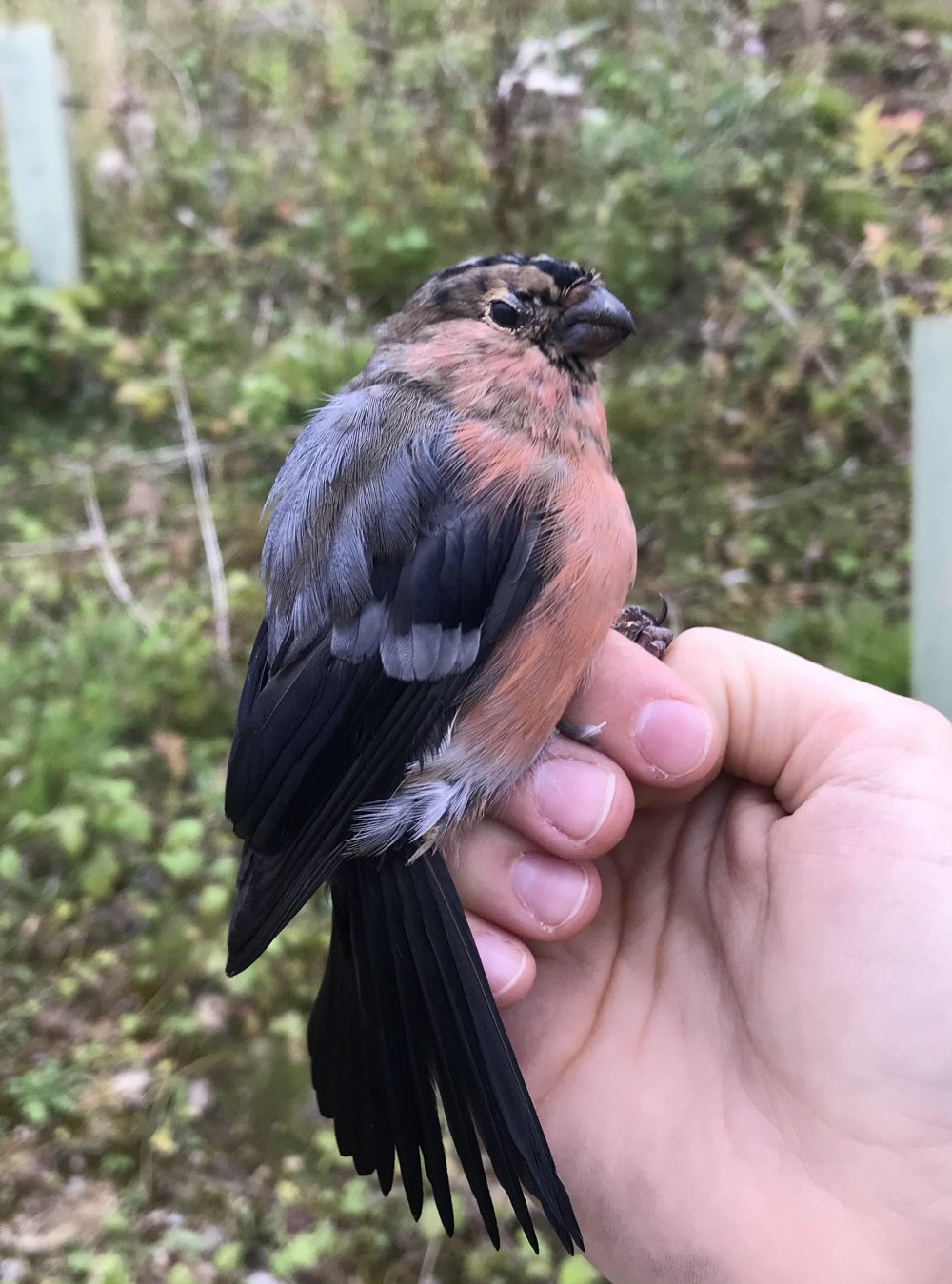
Other volunteers have been out hunting the invertebrates at Foxglove. Since the middle of August several volunteers have thought and been convinced that they had seen a Brown Hawker but it would not stay still long enough for final confirmation. But time and patience resulted in a photograph. Thanks for this Tim.
_male,_The_Scrapes,_Foxglove_Corvert_LNR,_N_Yorks,_UK.jpg)
Roger Key sent in his final list of species and included Berytinus signoreti, which although found all over the country is much rarer in the North. The adults hibernate over winter. This is a new species for the reserve.
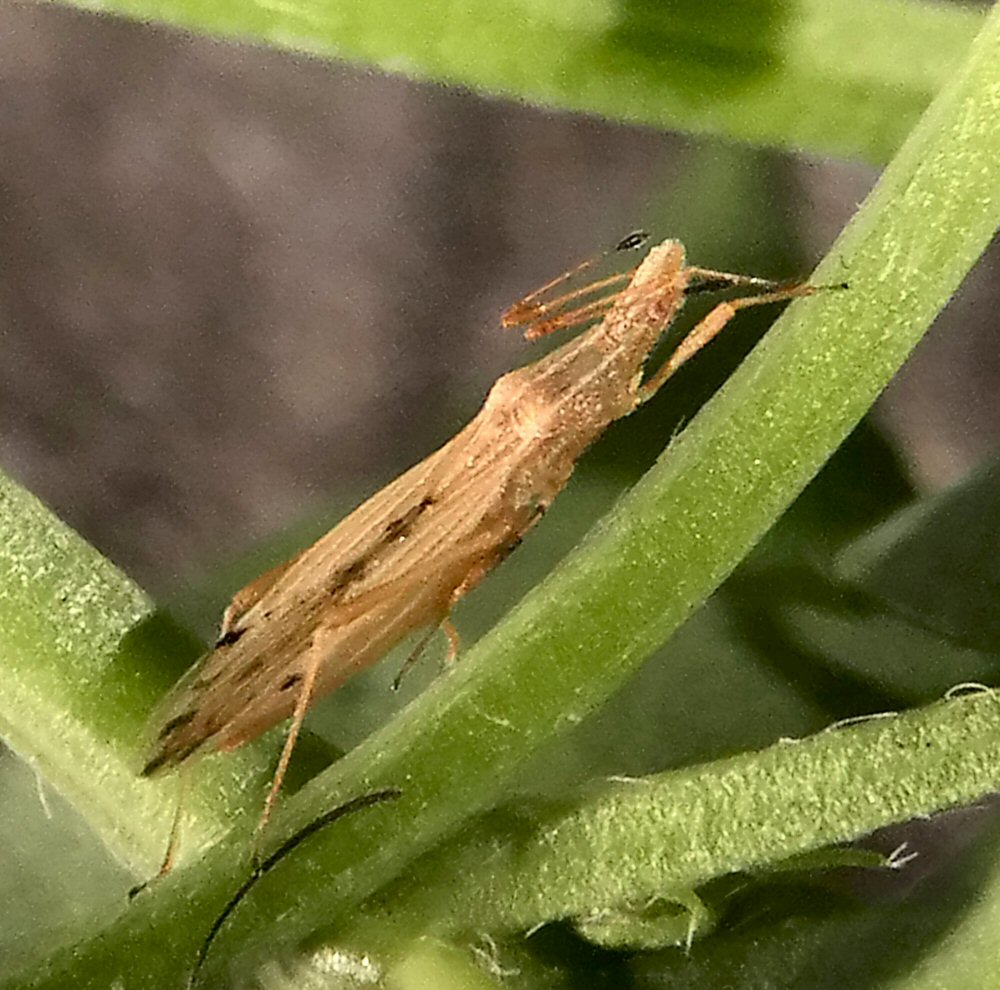
Another new species for the reserve is Rhopalus subrufus. This species is mainly found in southern Britain. Possibly climate change is encouraging it to find new areas in the North. It is often associated with St John's Wort of which there is plenty across the reserve.
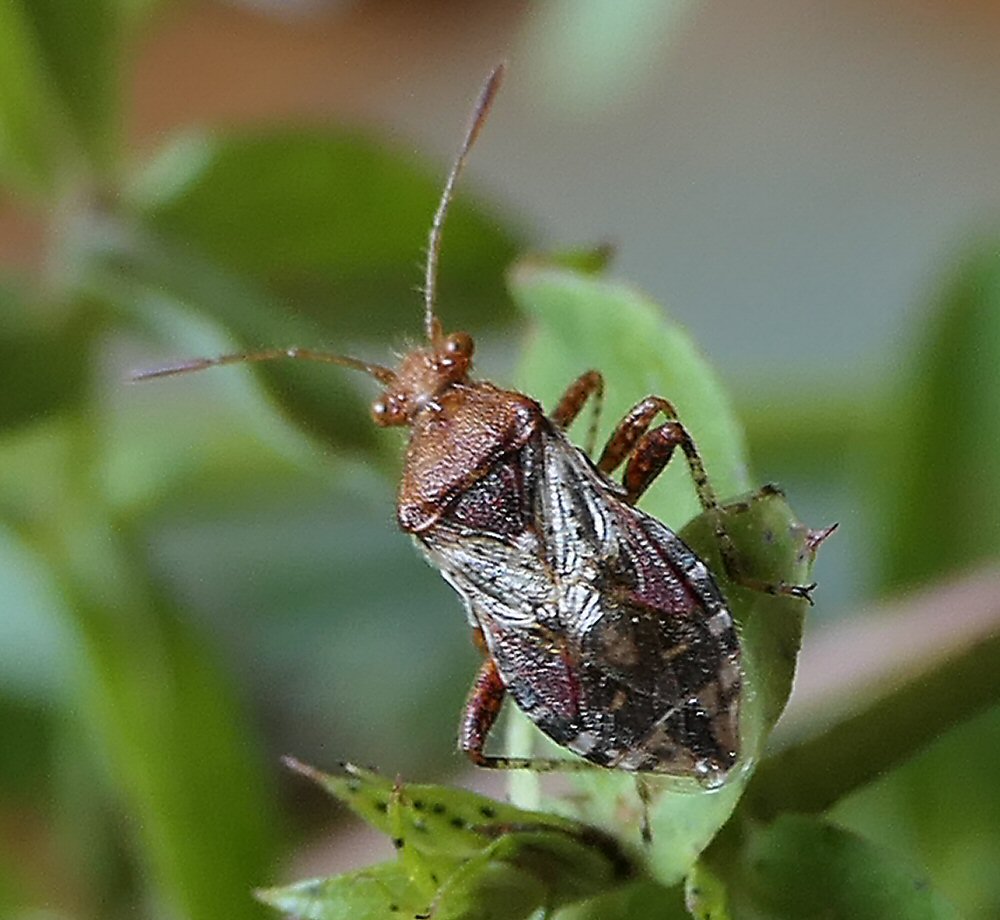
Thank you to all our volunteers for your varied work at Foxglove.
Queen’s Award for Voluntary Service
Friday, August 27th 2021
This morning the volunteers assembled outside the Field Centre to be presented with the Queen's Award for Voluntary Service by Her Majesty's Lord-Lieutenant of North Yorkshire, Mrs Johanna Ropner.

Lesley Garbutt (Chair of the Management Group) received the award on behalf of the volunteers whilst Sophie received the certificate.

In honour of the occasion the Lord-Lieutenant planted a Whitebeam tree.
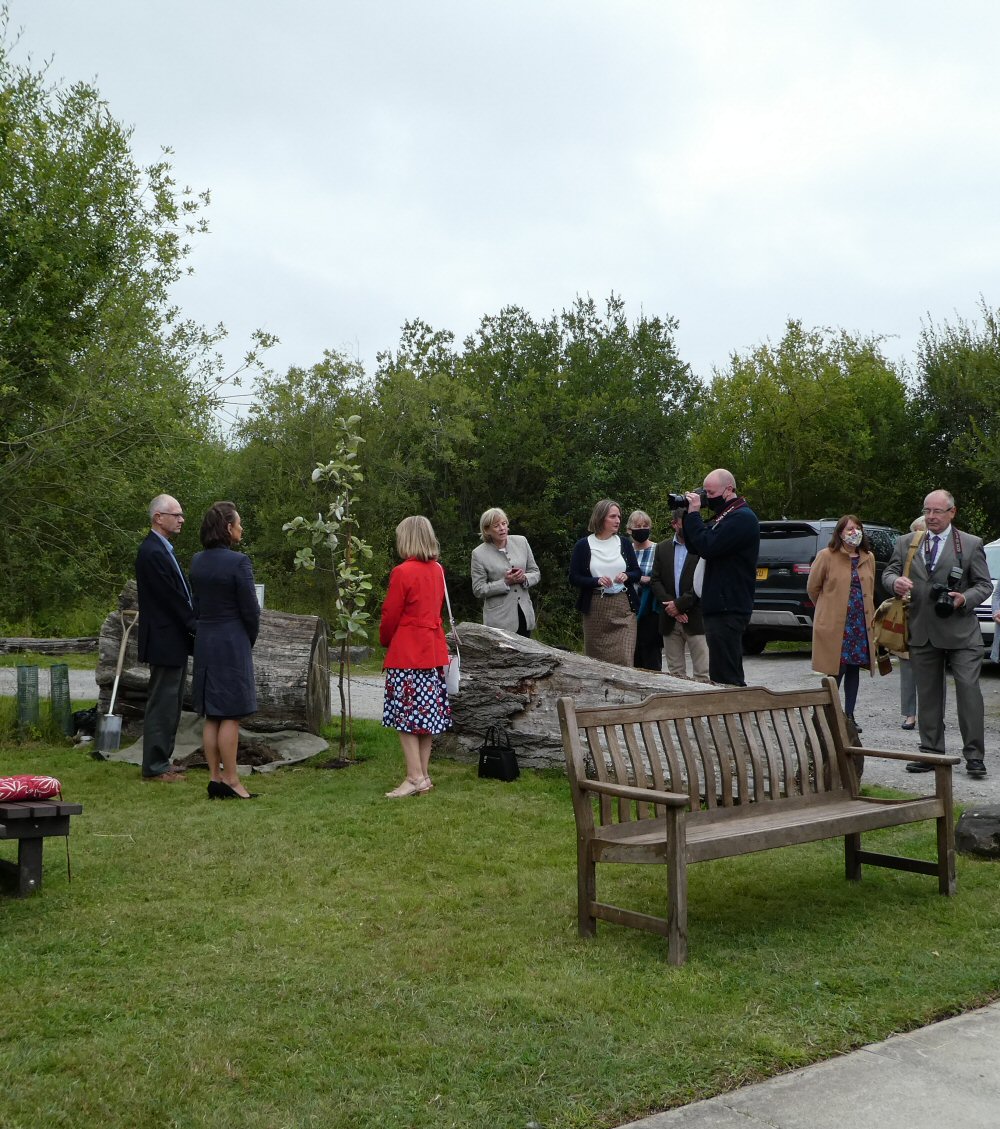
Our Patron the Marquess of Zetland, assisted by the Lord-Lieutenant, cut the celebratory cake.

Lord Zetland then handed out the pin badges to the volunteers.

Although this was the volunteers day, they were all involved in its preparation leading up to the event. Lesley said in her speech that Foxglove is renowned for its mosaic of habitats but we also have a mosaic of volunteers, bringing different skills to Foxglove. As always many thanks to them all.
End of Summer Tasks
Thursday, August 26th 2021
As autumn approaches the volunteers are busy with the last of the summer tasks. The workshop had been cleaned, undercoated and was ready for its coat of green paint. Many hands make light work.

Members from the PRC, Catterick Garrison attended today. They carried out a variety of tasks, including collecting the cut reeds from the reed bed which, although having been cut back recently, were still falling over the path making walking along the boardwalk and interesting experience.

Checking the stock, cleaning the hides, strimming and clearing the paths were all on the todo list. Many thanks to all the volunteers who helped to achieve a great deal of work by the end of the day.
A reminder that the reserve will be closed briefly on the morning of Friday 27th August and will re-open at 13:30. We apologise for any inconvenience.
Minibeast Safaris
Wednesday, August 25th 2021
Today was all about invertebrates at Foxglove. It began very early as volunteers emptied the moth traps that had been left out overnight. Then, later in the morning Entomologists Dr Roger and Rosie Key arrived to lead several 'family bubble' minibeast safaris.
In the past, these events have been held as one safari for a large group but this year due to extra covid 19 measures, there were several small parties instead. This meant that everyone had an opportunity to discuss their finds in more detail.
There were a couple of exciting discoveries; this Longhorn Beetle was first recorded at the reserve on the 14th of June 2017. The confirmed sighting was the most northerly record for VC65 at the time.
There was a chance to learn about the specialist equipment used in Entomology such as sweep nets that are moved through the vegetation to catch all of the 'creepy crawlies' lurking there!
Dr Roger Key demonstrated the best way to search the contents of the net without letting the bugs and insects escape!
Thank you to everyone who joined in with this special event and to Dr Roger Key and Rosie who never cease to amaze us with their vast knowledge of the macro world!
If you would like to learn more about wildlife then have a look at our events page to see what is in the pipeline. On Bank Holiday monday next week there will be a celebration of all things bee with our first ever 'Bee Happy Day'! There will be all kinds of hands on activities such as making a candle from beeswax, creating wildflower seed bombs and a 'Bee identification trail' around the red route.
Meet The Sheep!
Tuesday, August 24th 2021
Thor the Hebridean sheep has returned to Foxglove for a summer vacation from Gam Farm in Grassington with six of his fellow tups.
Along with him is Jett (another Black Hebridean), Kestrel, Caesar and John (Shetlands) and Percival and Aston (Borerays)!
They will graze in the wildflower and heather paddocks to help to manage these habitats. Look out for them as you drive into the reserve along the main access road.
Last CES
Sunday, August 22nd 2021
CES 12 today, the last one for 2021. Last week a juvenile female Sparrowhawk was caught, today it was the turn of a juvenile male. These birds are at the top of the food chain, males feeding on small to medium sized birds, like Blue Tits and Blackbirds. Females, being much bigger can take Collared Doves and Wood Pigeons. They are well built for speed to sweep through an open garden. Dense vegetation does not stop them as they have agility to twist and turn. Sharp beaks and large talons help then catch their prey.


One of Foxglove's volunteers rehabilitates injured birds of prey. Before they are released they are ringed. Usually they are released where, or close to, where they are found. Unfortunately this Kestrel arrived with no information so will fly from Foxglove. Unlike the Sparrowhawk, Kestrels hover over the land searching for mice and voles. Once they are spotted the Kestrel dives onto its prey.

The Swaledale Bird Ringers have worked hard to complete CES this year as the weather has certainly not co-operated. At the height of summer they would be at Foxglove for 4am. Congratulations. Volunteers have supported them to ensure that net rides and paths between them have been strimmed and overhanging branches that could snag the mist nets, cut back. Many thanks to everyone involved, all the hard work is really appreciated.
Forest School
Friday, August 20th 2021
This month at Forest School the group paused on their journey back from the woods to look at the felled Ash trees.
Earlier in the morning up in the woods they had a go at making bird feeders using apples, seeds and sticks (found on the forest floor).
There was also an introduction to fire lighting using flint and steel.
A good time was had by all and plans were made for next time when the hope is to toast some bread and make some butter to go with it!
Thank Yous
Thursday, August 19th 2021
There are lots of people to thank today, firstly the volunteers who rallied around to re-organise the seed stores after a delivery of chaff for the bird feeders.
This is thanks to a farmer who kindly donated 8 ton sacs of chaff from combine harvesters. The mix contains lots of rapeseed and poppy seeds which are enjoyed by flocks of finches in the winter months. The huge sacks were put into over 90 smaller sacks and taken to a different store, a tedious and strenuous annual task but one that was done in record time down to fantastic teamwork!
It is a dusty job too so PPE was essential; there are big smiles behind those masks, honest!

The sacks were loaded onto a trailer and then at the main store the stock was rotated to make sure that the older sacks from previous years are used first.
Not only was there a lot of activity inside the workshop, the outside also received a bit of TLC as the exterior walls were prepared for a new lick of paint.
Volunteers also painted the veranda in front of the Field Centre, strimmed along some of the footpaths and around the main gate and removed Bullrushes from the wetland. Members of the Management Group and our Undergrowth Editor were also working behind the scenes to prepare for the QAVS celebrations. All of this work is hugely appreciated.
Finally, our sincere thanks also go to TESCO for donating items from our wishlist today, these will make a big difference to the registered charity in the near future.
Thank you everyone for your valued support!
Big Sheep Little Cow
Thursday, August 19th 2021
Many of the habitats at Foxglove benefit from conservation grazing. An area in need of some 'browsing' and 'poaching' is the wetland including Plover's Pool where the vegetation is very tall after a summer of good growth. Dexter Cattle have grazed in this area before and are a good choice as they are small and light and therefore cause minimal damage to the delicate pipes and bunds in the wet meadows. Farmers from Big Sheep Little Cow (a popular farm attraction in Bedale) have kindly loaned 3 of their Dexter cattle to the reserve for a couple of months to help reduce the height of the sward. The heifer (brown) and two bullocks (black) were new to the reserve and keen to explore their 'holiday home'!
It is hoped that they will trample about in Plover's Pool which as you can see from the photo is completely filled with rushes and reeds.
After a quick run around they settled down close to some Hawthorns where they will find shade on sunny days and shelter from the wind and rain.
Thank you to everyone at Big Sheep Little Cow for their support and especially to Sophie and Duncan for giving up their evening to bring the cows to Catterick.
This and That
Wednesday, August 18th 2021
Firstly, an update on volunteering; it is that busy time of year, when the diary is full of jobs that all need doing at once to make the most of the good weather (in theory)! The veranda was cleaned and it must be admitted it was dusty and muddy and covered in little stones. Once it was spotless, it was rubbed down with a damp mop and allowed to dry. Then out with the paint!
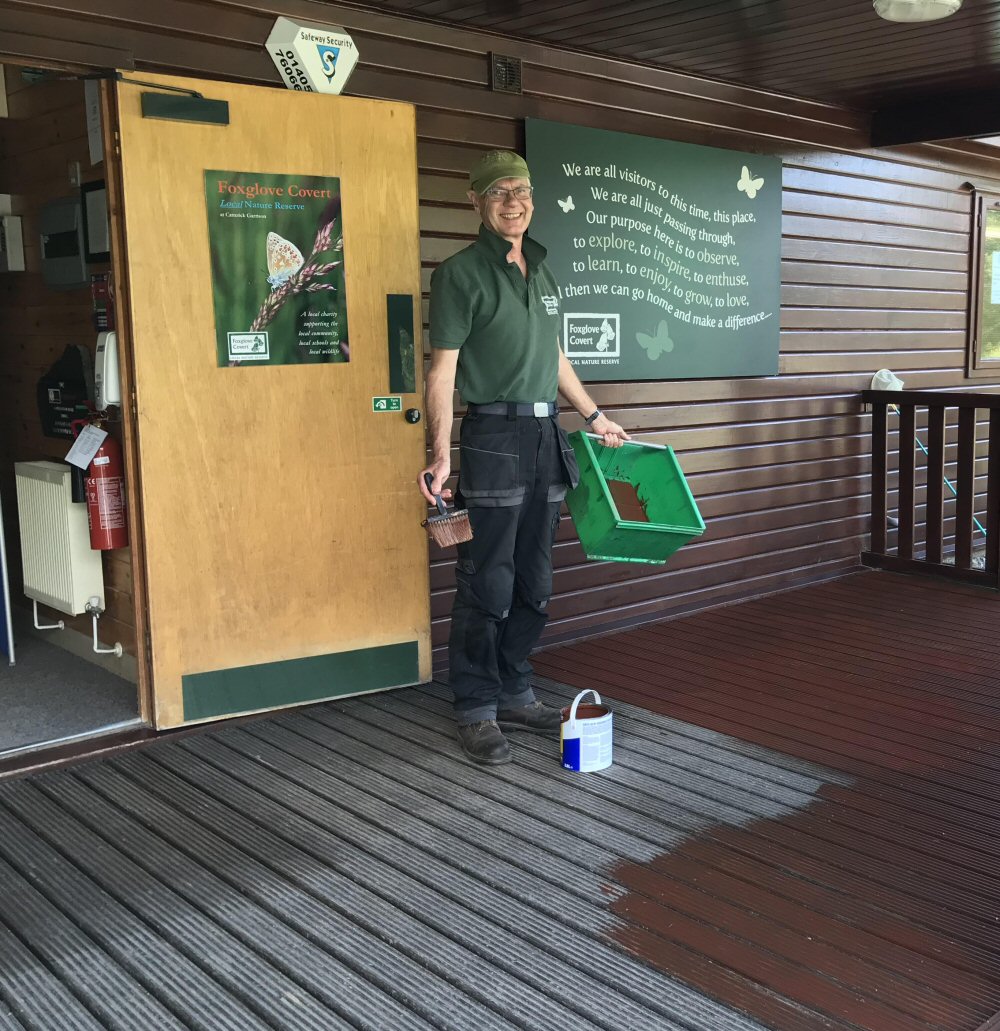
An interesting situation - what happens next?
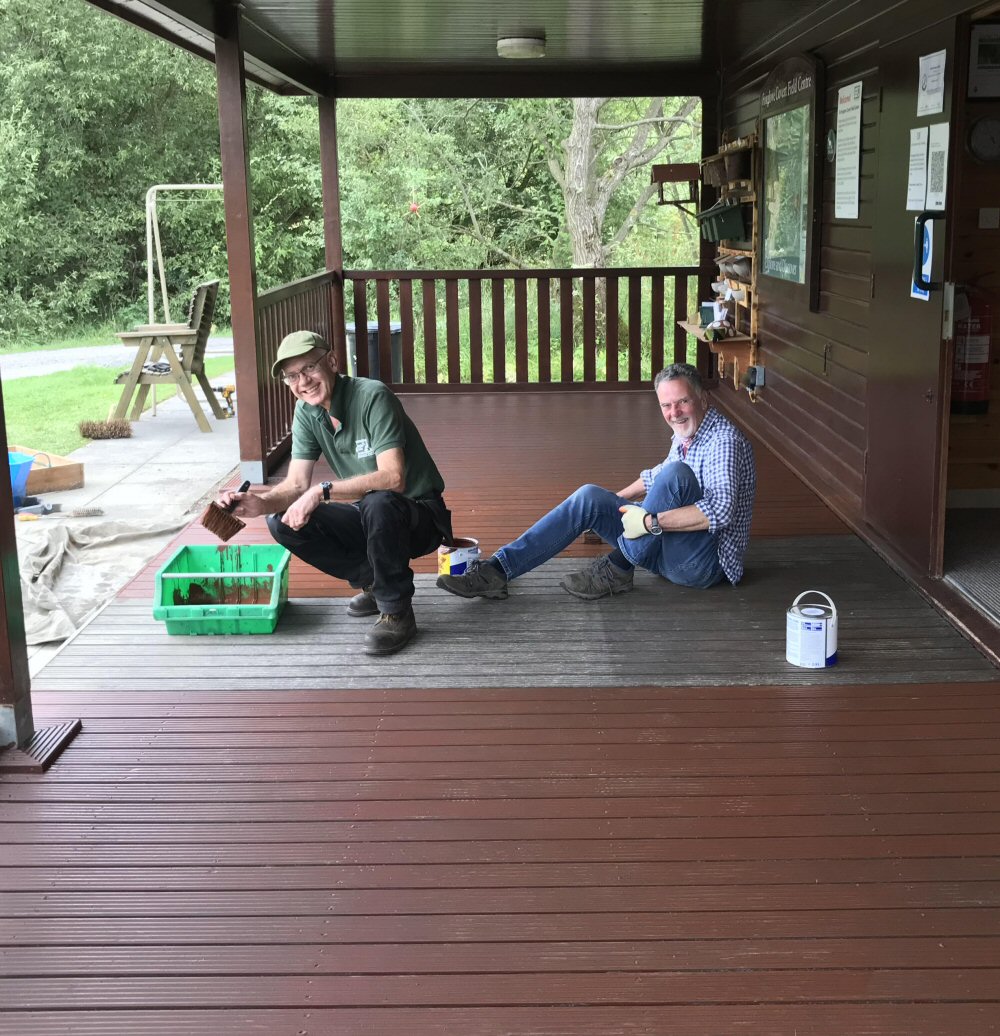
Volunteering takes many forms at Foxglove and today the 'Species Team' met up early to empty the moth traps and identify the contents.

Plenty of moths were caught and reference books were needed for careful identification.

A butterfly survey was also carried out by volunteers.
Very kindly, Dr Roger and Rosy Key have agreed to run a minibeast safari on Wednesday 25th August. If you would like to come along and find out more about many tiny creatures there are more details on the events page.
How many insects can you get on one Wild Angelica flower? Why are they all together?

Hoverflies feed from different flowers. Dr Key is sure to be able to answer these questions and tell you much more about minibeasts.

There has been a hatch of butterflies over the last few days and the warm sunshine brought them out in profusion. Peacocks and Red Admirals were on a variety of flowers, whilst the Brimstones were flitting here and there. They rarely sit with their wings open.
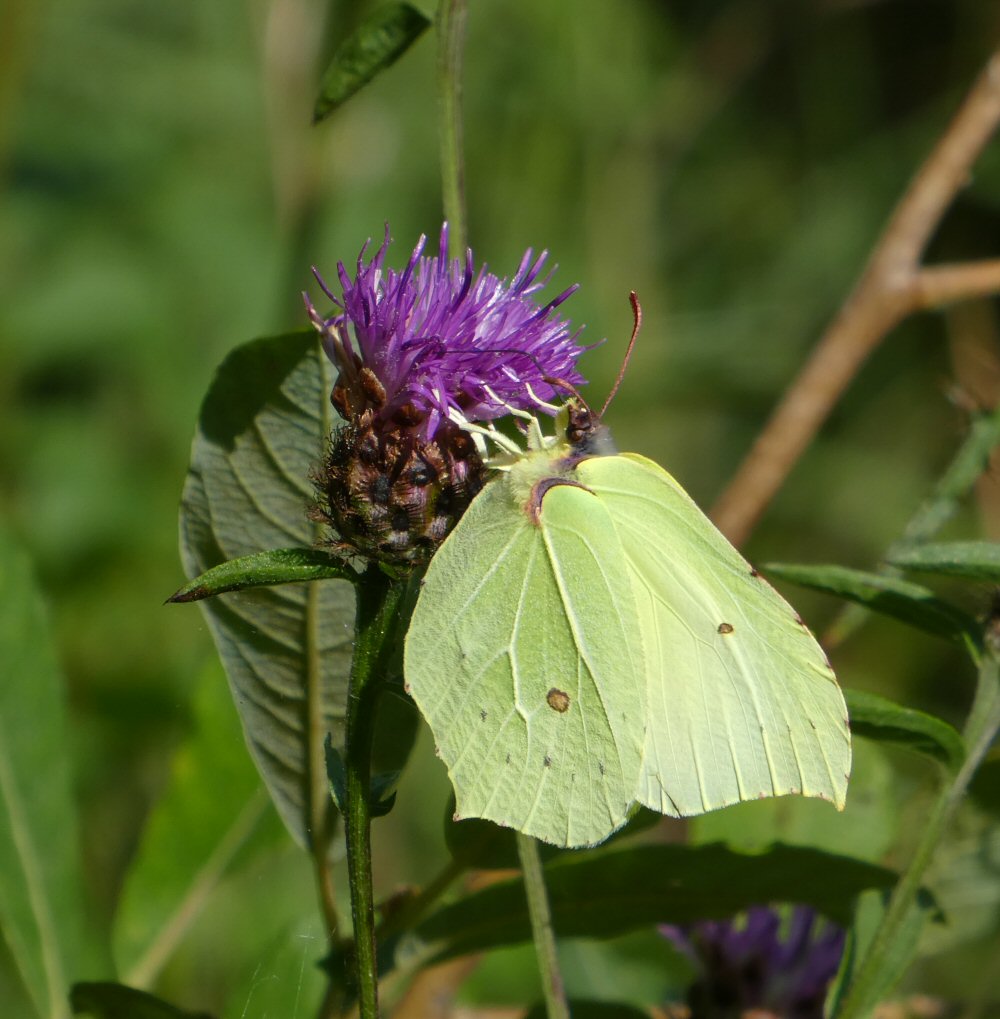
A very large moth was caught this morning and identified as a Red Underwing. It did not co-operate when being photographed so not even a glimmer of red. Once released from the pot it flew on its way revealing a flash of bright colour. This moth which flies in August and September, and comes freely to both light and sugar was last recorded at the reserve in 2008. The larva feeds on willow.
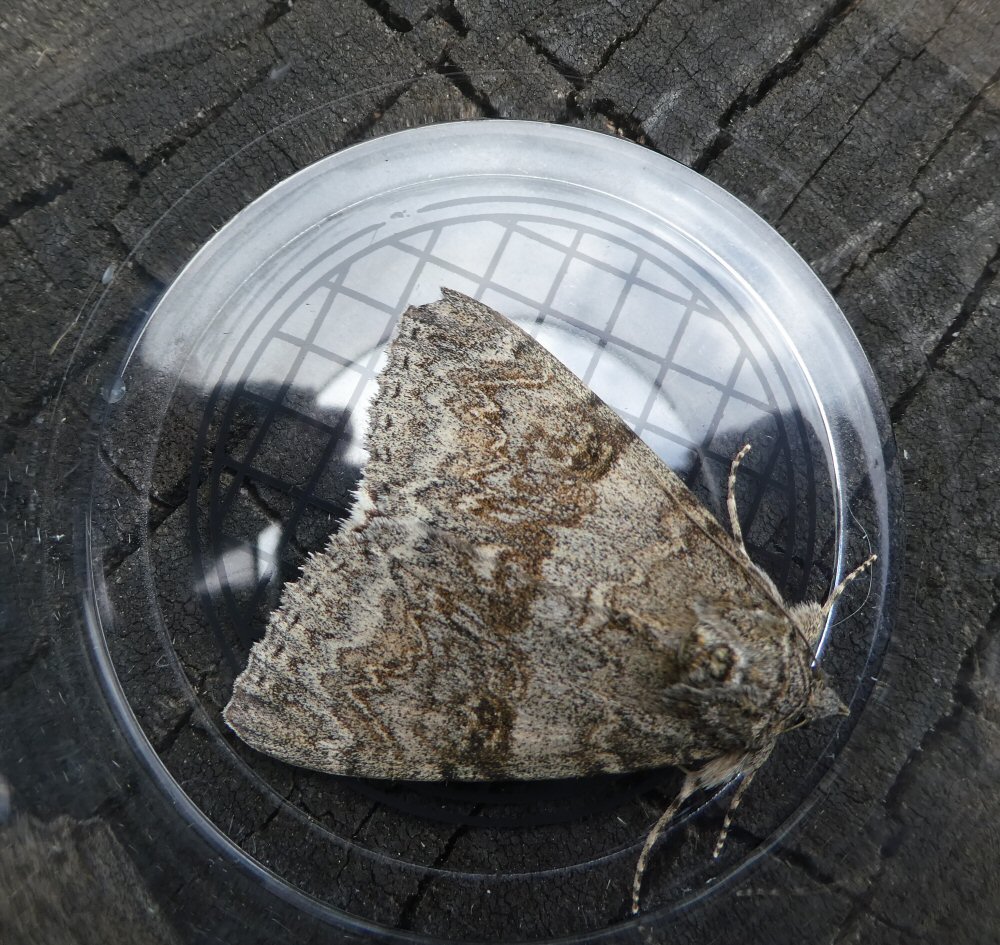
Thank you to everyone who has helped with so many tasks this week.
Finally, a notice to say that the reserve will be closed briefly on the morning of Friday 27th August and will re-open at 13:30. We apologise for any inconvenience.
Making Butterfly Feeders
Monday, August 16th 2021
Throughout the summer holidays there are lots of events for children; families visiting the reserve today had the chance to make butterfly feeders. This was one of the drop in wildlife craft sessions so there was no need to book in advance.
Thank you to our Chairperson Lesley who gave up her day to run this popular wildlife craft activity.
The next event will be a Minibeast Safari. Entomologist Dr Roger Key will be on hand to help identify the invertebrates that are discovered during this 'family bubble' event. Booking is essential for this activity as there will different time slots. See the events page for further details.
Getting Stuck In
Monday, August 16th 2021
The bridge on the Red Route is open again and work has begun on clearing some of the excess reeds from below it; pulling them out by the roots was the best option to prevent them from re -growing.
There were a few close shaves when people almost lost their balance as the roots finally gave in to the pressure and mud splashed everywhere!
The reeds were so thick that it was difficult to know where to begin.
After a couple of hours, a small clearing had been created, this will help the flow of water into the lake and make a corridor for birds such as the Kingfisher.
The team then moved onto the wetland to carry out some habitat work there. There was less silt but the water was deeper which led to different problems!
Special thanks to all of the volunteers who have worked on the bridge and in the ponds, it will benefit both the wildlife and the visitors who come to enjoy it.
Surprises
Sunday, August 15th 2021
At 0841 there was a surprise in the mist nets. A juvenile female Sparrowhawk had been caught. Usually the females are too big and heavy and so bounce out of the nets. Males, being smaller can get caught. These birds can been seen sweeping through the back garden.

The Green Woodpecker has been annoyingly loud and annoying well hidden. People have searched for it here, there and everywhere to no avail. Not even a suggestion of a sighting. It was caught out and was found in a mist net. Absoutely amazing, only the 10th time one has been caught since 1992.

The red malar stripe, the red stripe on its cheek, is just starting to appear, this makes it a juvenile male bird. Their ideal habitat is mixed deciduous woodland edges. They feed mainly on the ground, as they hunt for ants nests.
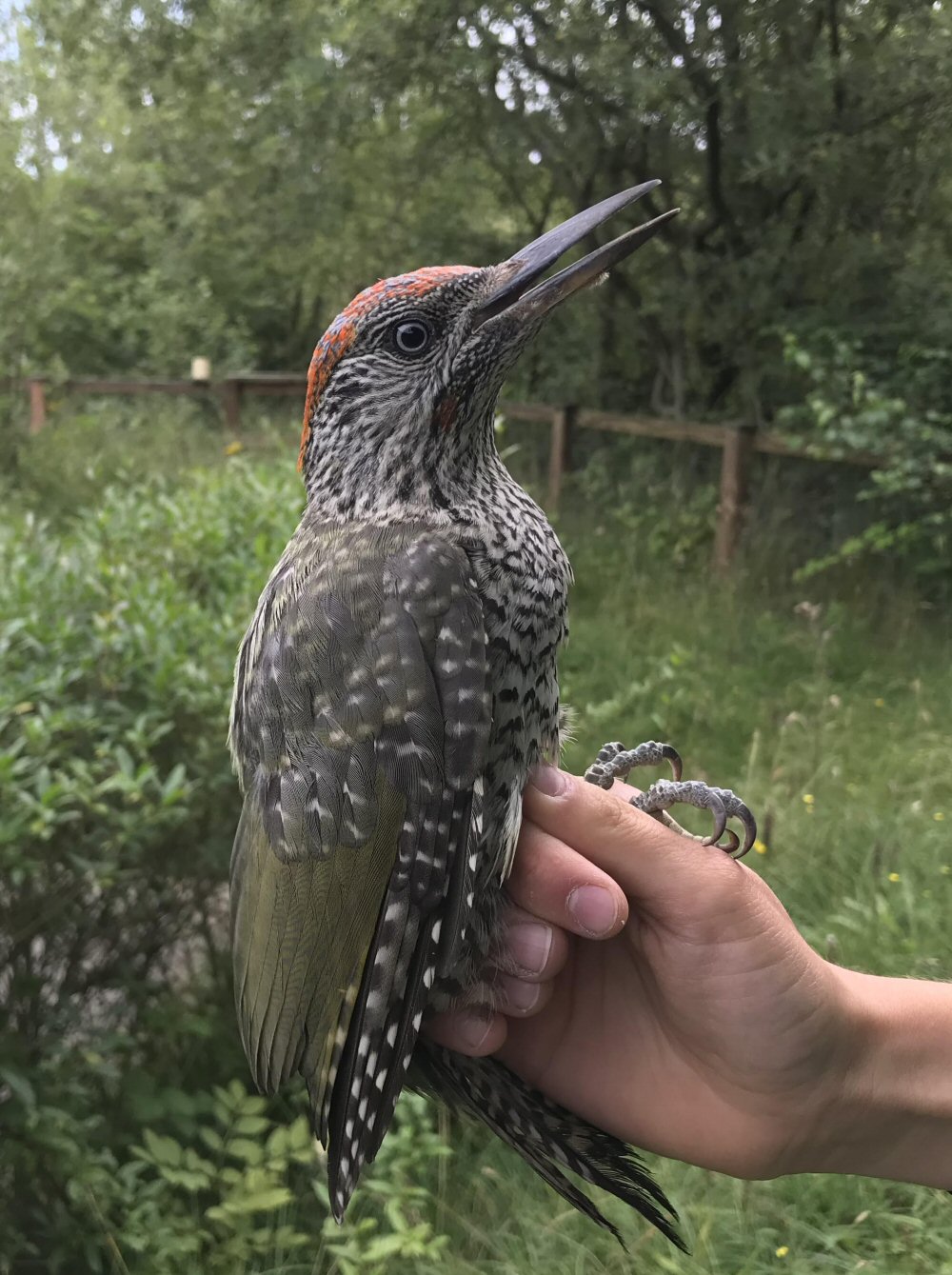
Other juvenile birds made an appearance in the ringing room, many going through their moult from juvenile plumage to that of an adult. Robins change from a speckled breast to a red one. They look like they have come into contact with a powder puff of red paint!

Other animals are also looking to change. This large caterpillar of the Elephant Hawk-moth is large enough to be ready to find a suitable place to spin its cocoon. Usually they are darker in colour but the eye spots help with ID. They overwinter as pupae in fragile cocoons at the base of plants, in loose plant debris/litter, or just below the surface of the ground. May through to July is when it can be seen, often feeding from Honeysuckle and other tubular flowers. It has been recorded in the moth traps, this year, on several occasions. Thanks to Hayley for spotting this and photographing it.

Many thanks to the Swaledale Ringing Group, who started their day at 0500 and finished at 1700. An excellent day. All the data they collect goes to the BTO, who collate it to give an understanding of what is happening to our bird populations. Thanks also go to the volunteers who ensured that the net rides and paths between them are kept in pristine condition.
Late Summer
Saturday, August 14th 2021
There are many white butterflies around and people are reporting them in their gardens. Unfortunately Red Admirals, Small Tortoiseshells and Peacocks are rarely being recorded, probably because of the wet and the cold earlier in the year. However in a sunny spell a Peacock fluttered into the grasses. No way to get any sort of photograph so the vegetation was gently moved and the butterfly moved all four of its wings, making its eyes very apparent. They appeared to blink! This was obviously the stategy to scare off the predator, me, but giving the opportunity of a lovely photograph.
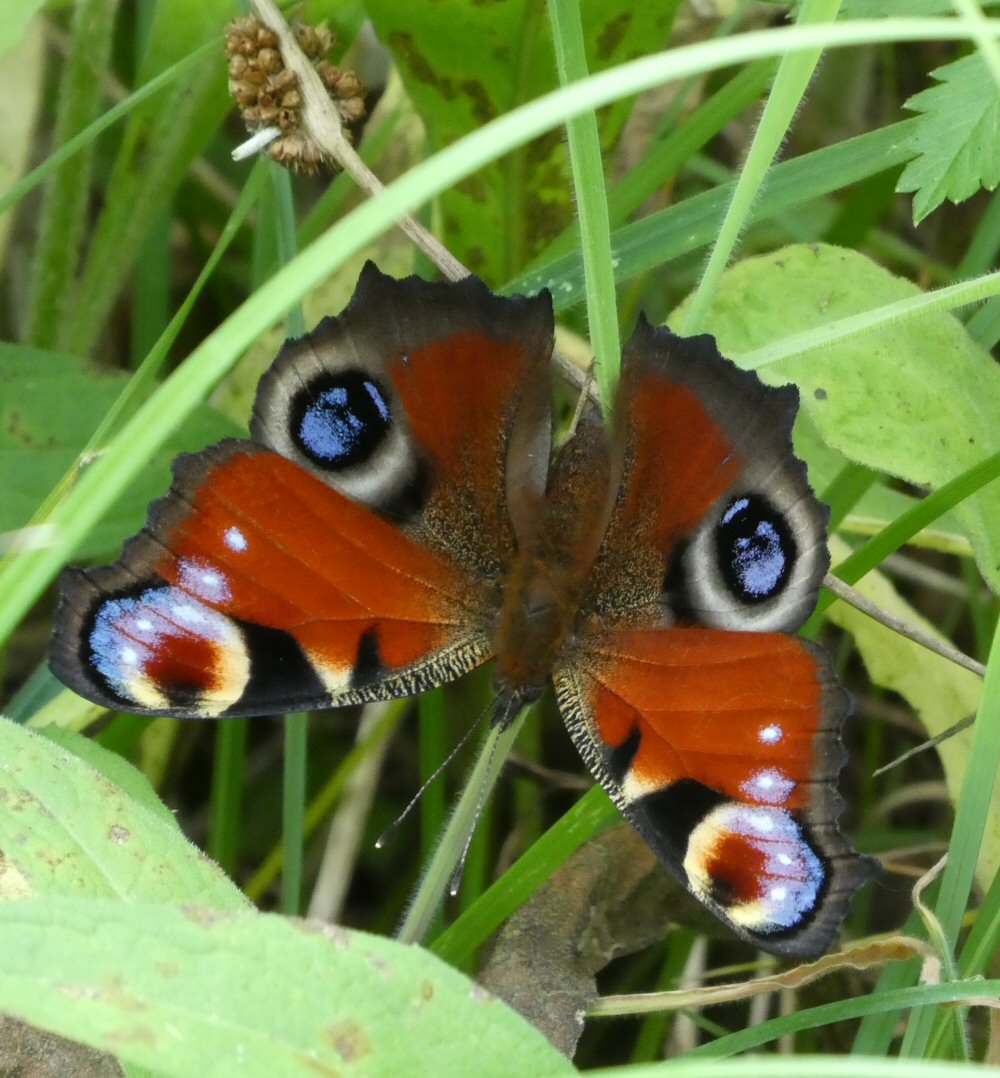
The late summer flowers are beginning to show themselves. Last year Wild Carrot was in short supply with very few of their white showy heads to be seen. We thought it was going to be the same this year but walking around there are more appearing.

Yarrow is also in flower.

Teasels are doing well this year. This is a biennial, taking two years from seed germination to flowering.

Once the seeds have been released the head remains and apparently is a comfortable spot of a Seven-spot Ladybird

Late summer is also a time for some of the fruits and berries on the trees to ripen. Guelder Rose berries are almost completely red.
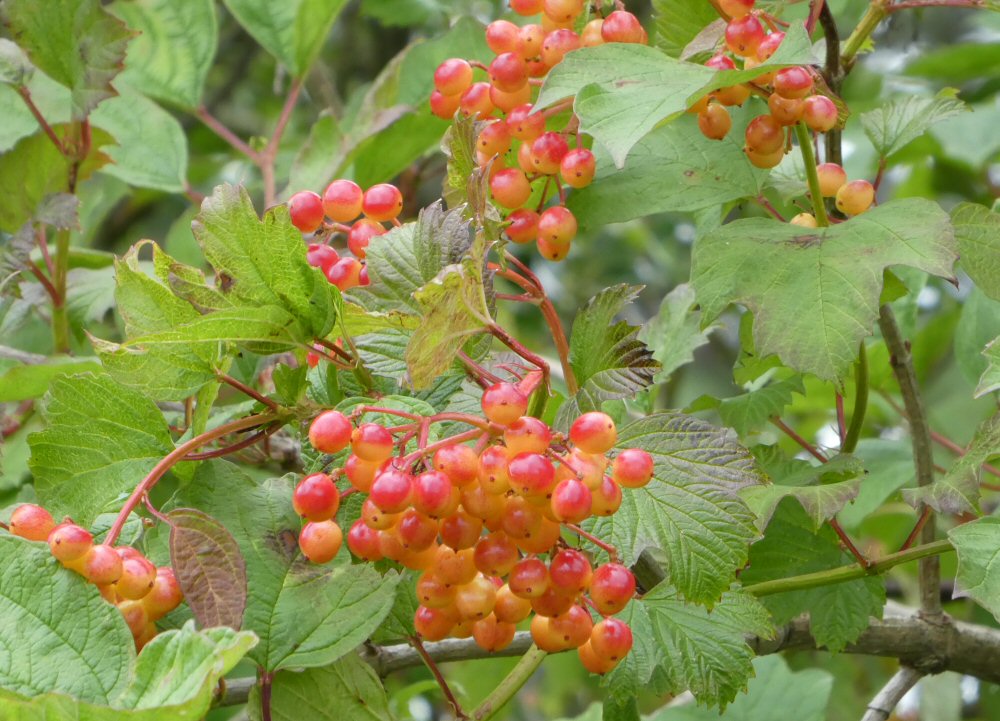
Reeds, Raking and Ragwort
Tuesday, August 10th 2021
Team Tuesday were hard at work again today: the first job was to put up the QAVS (Queen's Award for Voluntary Service) banners. One on the Field centre and a special wind-proof one on the perimeter fence.
The next job was to cut back the reeds that the rain had pushed over the boardwalk (this job was only done last week but heavy showers meant it needed to be done for a second time). A full ton sack was filled with the cuttings!
This was all done before coffee time and then the group headed to the stone circle to cut back the vegetation on the Bluebell bank. Now that the Bluebells have gone over, cutting and raking is a great way to spread the seeds and to remove excess nutrients. It was noticable that the Bracken in this area has reduced significantly through this management which will benefit the wildflowers.
With many hands it still wasn't light work! There were 4 people with strimmers and 4 with hay rakes.
Although the clouds threatened, thankfully the rain held off and the cut grass soon dried.
Two new strimmers provided by the Co-op made a huge difference and meant the task could be completed much quicker than in previous years.
In some places Harebells, Tormentil and Ragwort were still in flower and these were left as a valuable source of nectar for invertebrates.
Although harmful to livestock (there isn't any on the reserve at the moment), Common Ragwort is one of the most frequently visited flowers by butterflies in the UK and more than 200 species of invertebrate have been recorded on it. It is the foodplant of the black and red Cinnabar moth: sometimes its black and yellow barred caterpillars cover the plant, totally stripping the leaves. This hoverfly was spotted as the team were packing up for the day.
Many families have enjoyed visiting the reserve this week and the 'Make a Bird Feeder' activity from Monday has been left out in the classroom so you can still have a go at making a treat for your garden birds.
If you do visit this week, part of the red route is currently out of bounds whilst repairs are carried out on one of the bridges, we apologise for any inconvenience and are hugely grateful to Bob for all of his hard work and time spent on making it safe.
Wildlife Craft Activity - Make A Bird Feeder
Sunday, August 8th 2021
Would you like to help out the feathered friends in your garden? Why not come along tomorrow (Monday 9th August) between 10am and 3pm and make a bird feeder for your garden birds. You can take it home to put in your garden or hang it in a tree on the reserve. This is a drop in session so no need to book in advance. A suggested donation of £1 per feeder would be appreciated on the day to cover costs.
Ringing Update
Sunday, August 8th 2021
The Swaledale Ringing Group have had an extremely busy year so far. Over 100 large nest boxes were checked and monitored earlier in the year and many Kestrels, Tawny Owls and Barn Owls were ringed as a result. In addition over 500 nest records have been recorded for small nest boxes. These were home to Blue Tits, Great Tits, Pied Flycatchers, Redstart and Marsh Tits plus a few bees, wasps and even mice! Open nests have also been studied such as this Swallow nest which has produced two broods of 3 chicks.
The tenth CES (Constant Effort Scheme) visit was carried out today meaning a 5am start for the team who were rewarded with this stunning rainbow over the Field Centre!
As usual for Foxglove the species of the day was Bullfinch with 18 new ones being ringed. The weather wasn't as bad as was forecast and although the session ended early this was due to high winds rather than rain.
The group have broken a couple of records this year (compared to previous years) with the ringing of over 400 Black-headed Gulls and an amazing 38 Buzzard chicks. This all involves a huge amount of effort in finding the nests, observing the birds and then actually reaching them in the tree tops! Huge thanks to Martin Robson who found over 18 nests this year and to Sean Stockdale from Yorkshire Tree Specialists who climbed to the nests and lowered the chicks down to be ringed. He also waited patiently in the canopy before carefully returning them to their nests.
The Buzzard chicks varied in age from young ones still covered in down…
...to ones over 40 days old with most of their flight feathers…
...and everything in between!
Out on the training area hundreds of waders have been ringed (Curlew, Lapwing, Oystercatcher and Golden Plover) and we are continuing to work alongside and train gamekeepers to ring waders on their patch too.
Other exciting opportunities have included ringing raptors such as Merlin chicks.
Finally, we have been involved with the monitoring of Hen Harriers in the North of England too.
Thank you to everyone who has involved us in their projects, each experience is a huge privilege and to all of the ringers who have spent hours of their time helping out with all of the above!
More Moths
Friday, August 6th 2021
At the final count there were 167 species of moths recorded with 13 of these being new species for the reserve. There were 166 July Highflyers, 51 Brimstone Moths and 178 Large Yellow Underwings amongst the total.
A beautiful moth caught was Mother of Pearl. It is always interesting to check the larval foodplants and for this moth it is mainly Common Nettle, of which the reserve has plenty and also Wych and English Elm which can be found around the reserve. This is a micro moth although not tiny in size as some are.
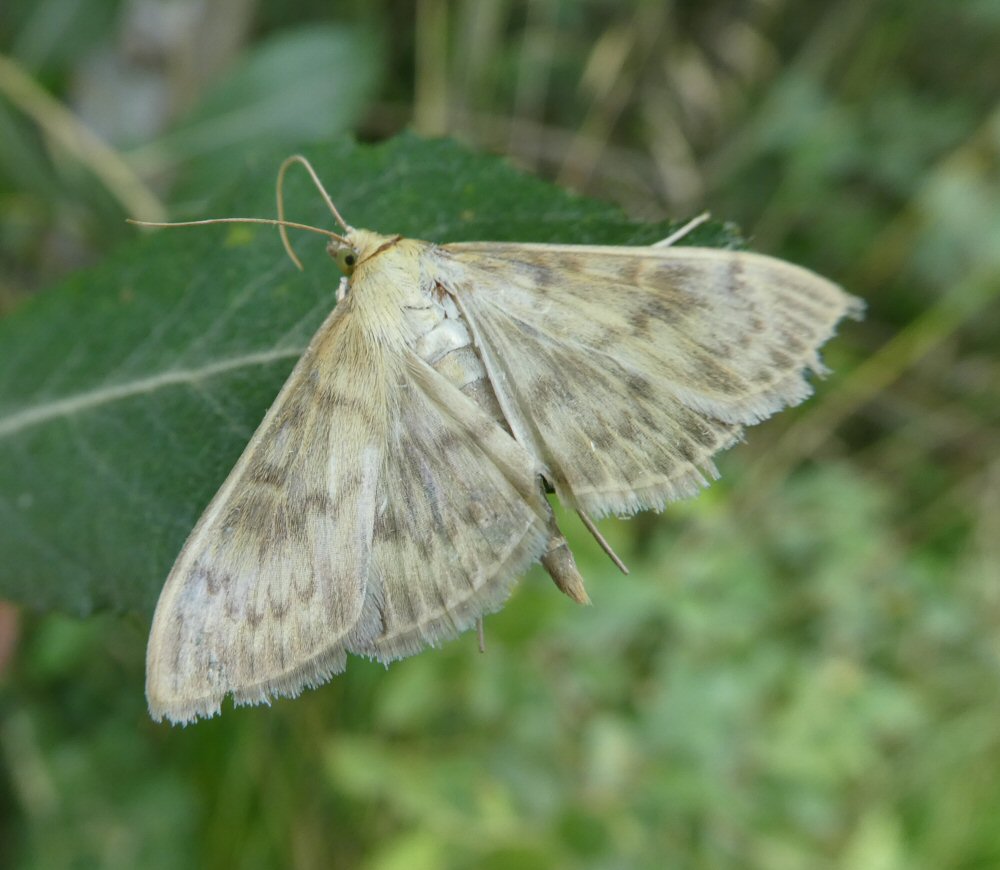
A smaller micro moth is Pyrausta purpuralis. It is a common moth but more local in Northern England. It obviously likes Foxglove as 20 of them were recorded. The larvae feed on members of the Lamiaceae (Labiatae) family and this includes mints. Mint likes damp places and can be found on the damper areas of the moor, around the lake and cascading ponds as well as throughout the Scrapes.

This tiny macro moth resembles a bird dropping and this possibly saves it from predation if it is on the outside of the trap. Crab Apple, Bramble, Pear and Blackthorn are included in the plants for the larvae.

Although we have many of the food plants for the Swallow-tailed moth we do not catch many of them. As moths age they can lose their marking and their colour. The red dots have faded from the tips of its hind wings.

Scalloped Oak caterpillars feed on a range of shrubs including Silver and Downy Birch.

Iron Prominent flies during June and July. Further south there are two generations and these fly from May to September. This moth has furry legs!
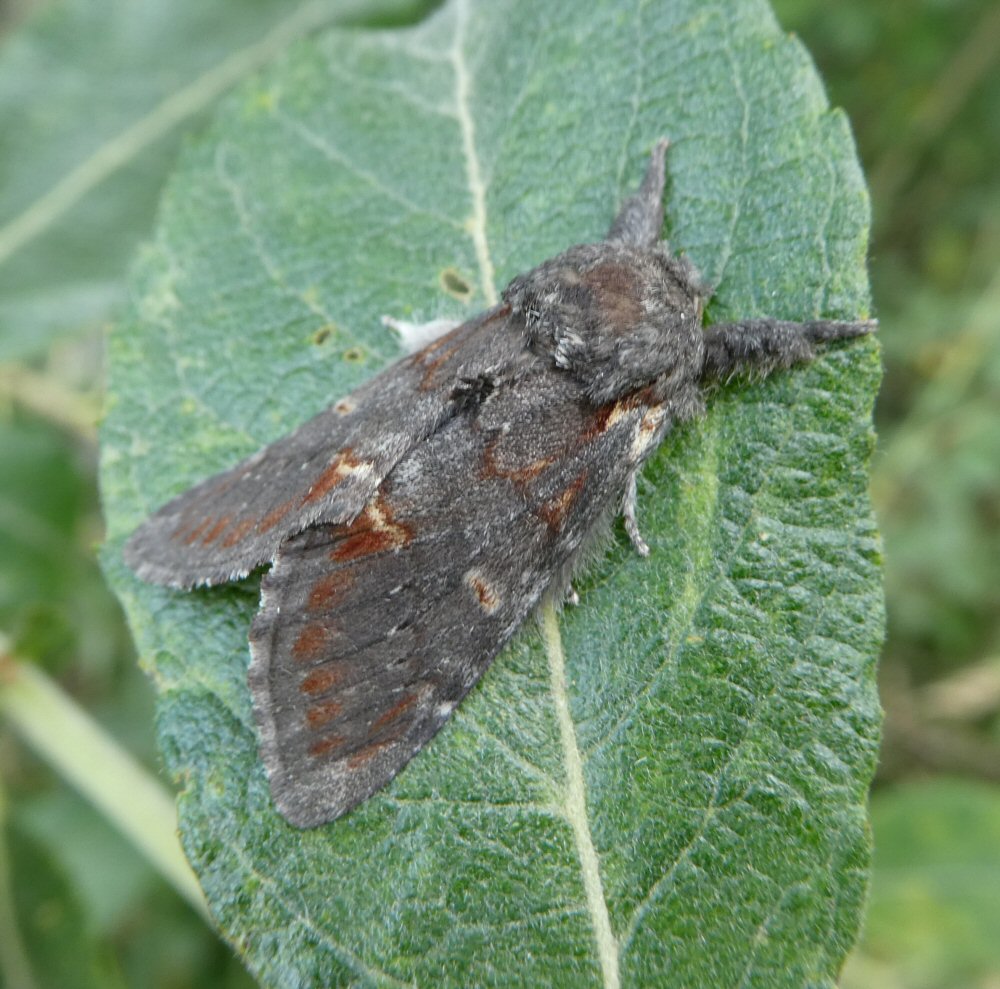
The star moth was Pammene populana. The only county records in the last 50 years are from Bellflask and Nosterfield so it’s nice to see it occurs at Foxglove.

An Amazing Moth Morning
Thursday, August 5th 2021
First some facts and figures; 11 moth traps set around the reserve.
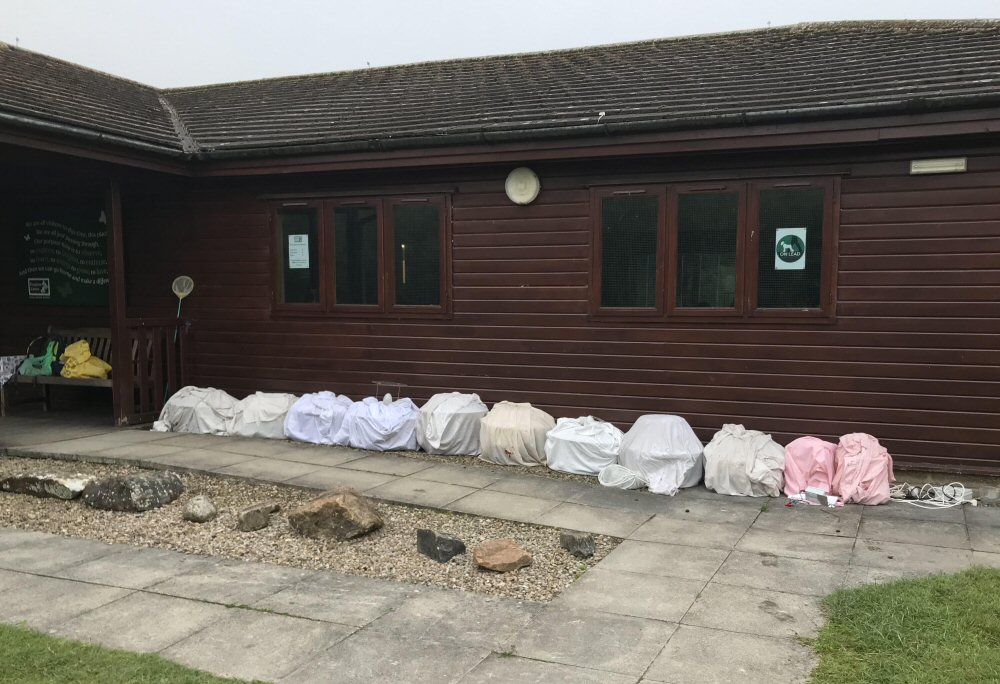
Each one had a power supply which was switched on at dusk and off at dawn. White sheets were placed underneath the traps to encourage the moths. 66 species were recorded on the sheets before the traps were even opened. The number of species by the end of the morning was 157. This total may increase when Charlie Fletcher (Moth Recorder for VC65) continues the identification at home. Not only did he identify the moths but he acted as scribe too. It took 4 hours to empty all of the traps.

There were two new macro moths for the site, the first being Light Knot Grass. Its flight season is from late May to mid July. It frequents acid moorland, heaths and bogs. Larval food plants include heathers and sallows both of which flourish at the reserve.

Earlier in the year Common Heath moths were discovered in the heather paddocks too. It was recorded in 2004, 2005 and 2008 and then not seen again until 2018, with increased numbers during 2020 and 2021. These moths are able to thrive because of the valuable work that the volunteers carry out on the heathland. It is not the easiest of tasks and the work done is appreciated. Charlie observed that the Heather looked better this year than in previous years.
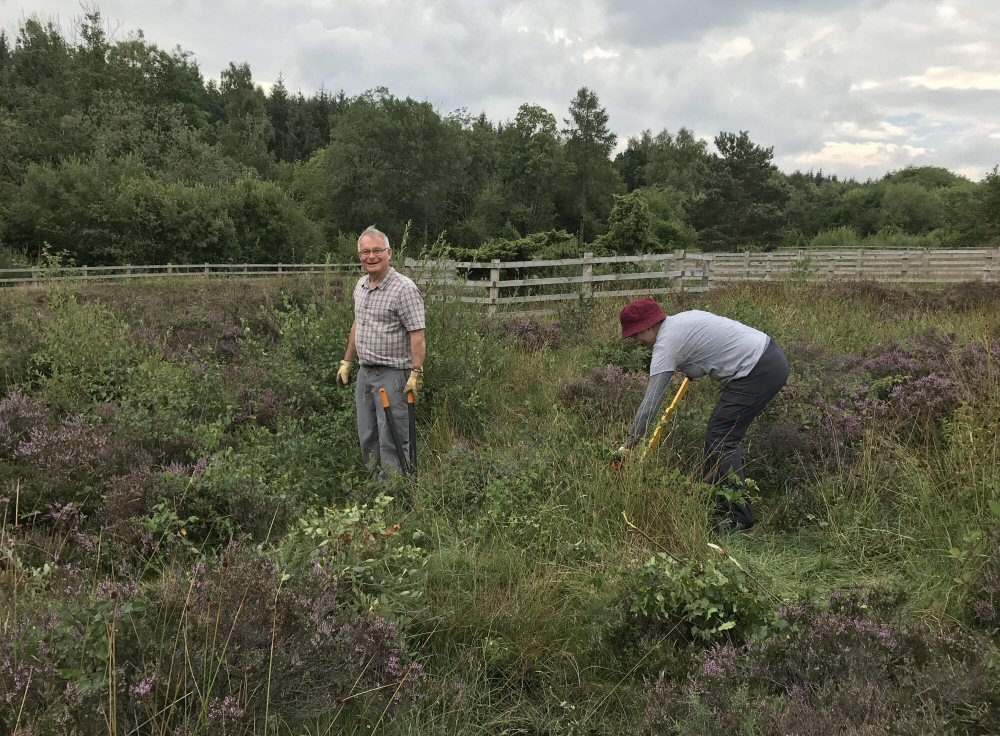

The second new species was White Satin Moth. This moth was not quite as co-operative so only a back view was taken on the log. I was amazed at it huge antennae!

What was more startling was the fact that it has striped legs, which were on view as it left the container. The larvae feed on aspens and willows. There are plenty of these at Foxglove. It would be nice to see more of these moths in the traps.
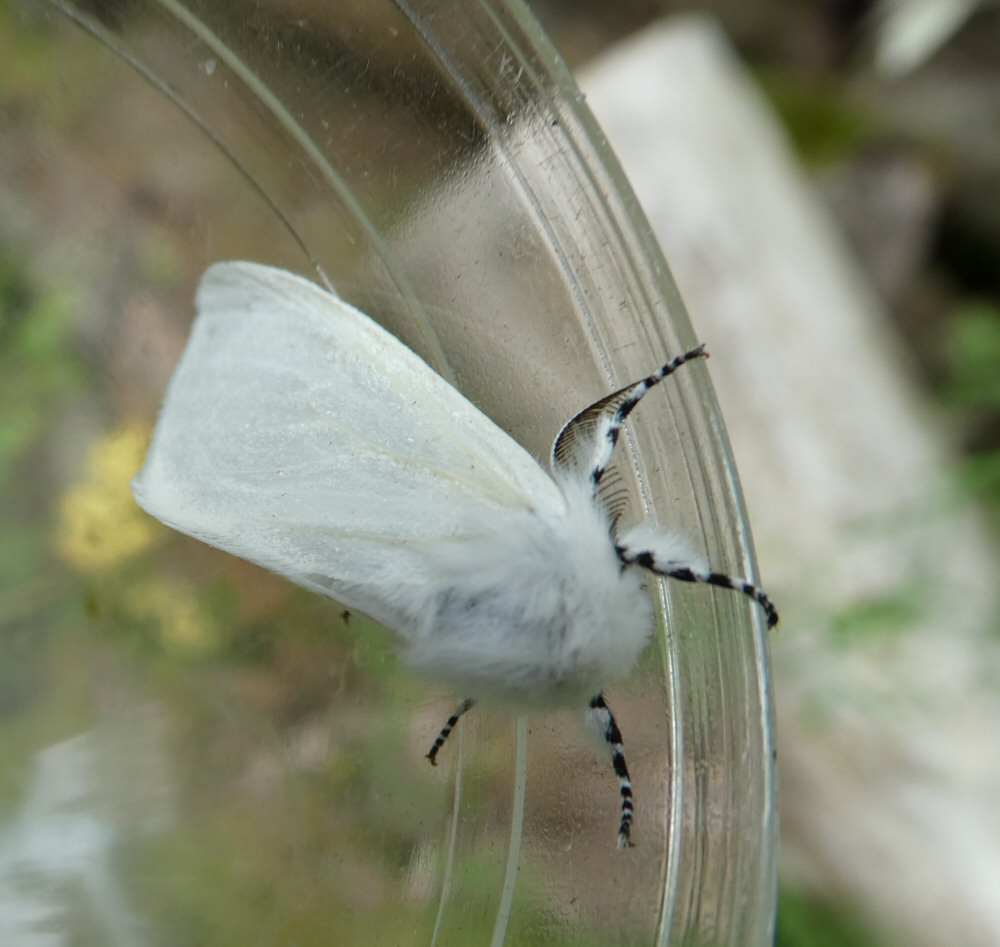
Once the moths had been identified they were released back into the wild from the egg cartons. These ones were gently encouraged into the vegetation, away from birds!

In the catch yesterday was one Drinker Moth, today we caught another two. The first and only recording of this moth was in July 2013. Its caterpillars feed on a range of coarse grasses.
Downy and Silver Birch, Hazel and Alder are the food plants for the caterpillar of the Large Emerald Moth, which can not be mistaken for anything else when it is in the trap.
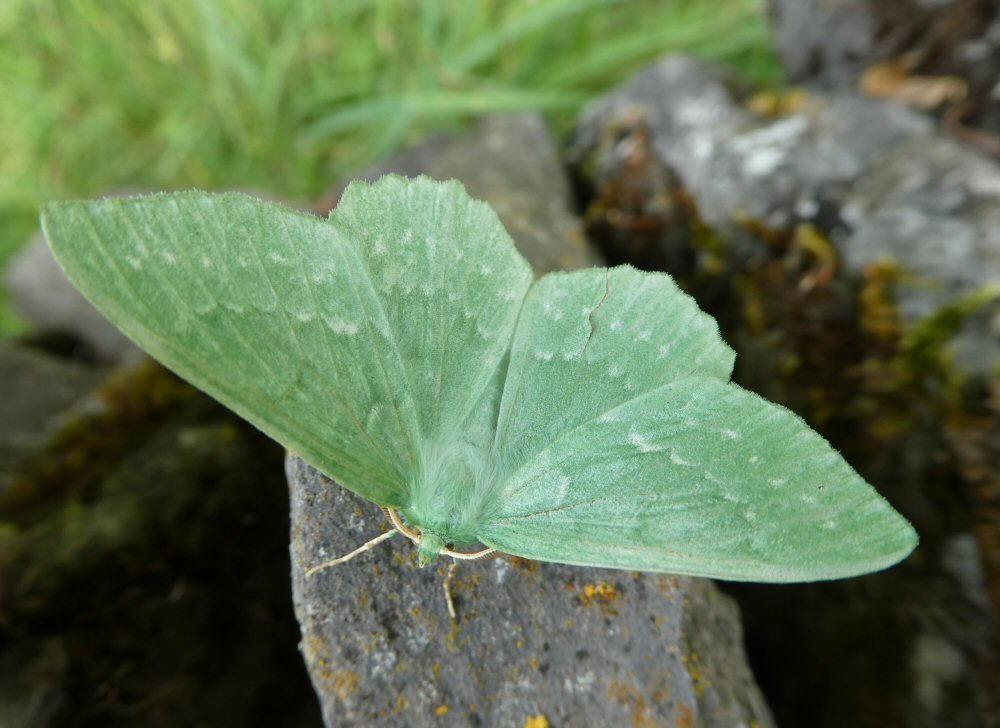
Members of the public enjoyed learning about these incredible nocturnal animals too. A couple of very young visitors had a closer look at some of the big colourful specimens in plastic pots. They were suitably dressed for the occasion!
Huge thanks to everyone who helped with the event today, with special thanks to Charlie who ID'd all the moths and Sophie who was up at 5am and joined him to close all the traps and to Ian Tunstill for helping to get the generators up and running! We mustn't forget the volunteers who keep the habitats in pristine condition so allowing all these moths to thrive and be part of the food chain for many other animals. A brilliant morning!
Getting Ready
Wednesday, August 4th 2021
There were some dramatic skies over the reserve this afternoon.
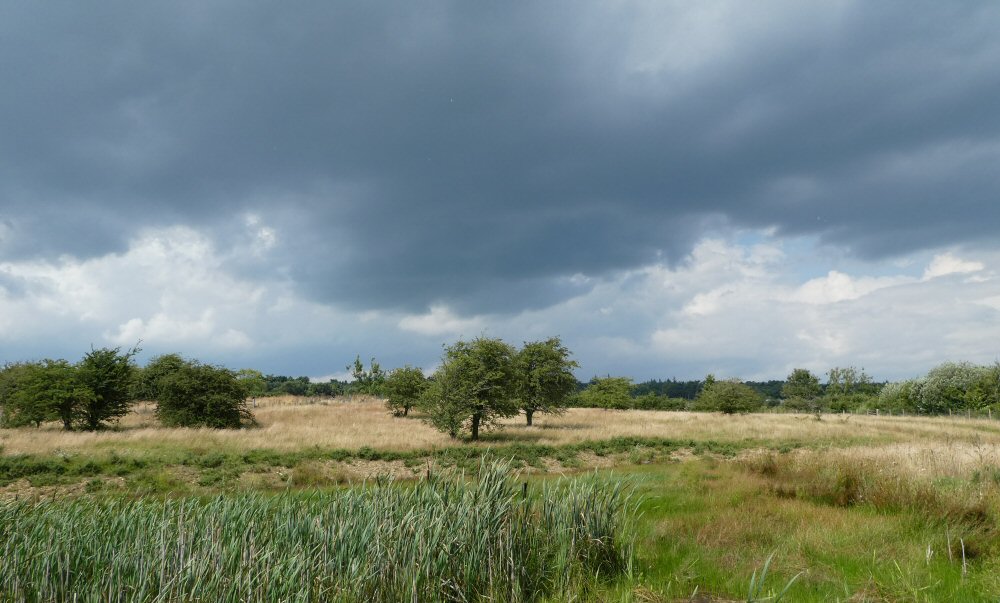
It stayed dry as the last two Barn Owl chicks were ringed. These beautiful owlets were so quiet and settled as they received their rings. A photograph was taken and you can see that they are beginning to lose their white down and gain their feathers.

Changing angles it brought a smile to our faces as the younger of the two definitely had a funky topnot! It will not be long before these two fledge.

Hopefully the breeze will continue to head the rain to the east as it is moth night tonight. It takes a considerable amount of time to set up as there are five to seven moth traps set around the reserve. Each needs a power supply and so the generators had to be brought into action. Unfortunately this one proved unco-operative. Ian came to the rescue - thanks Ian.
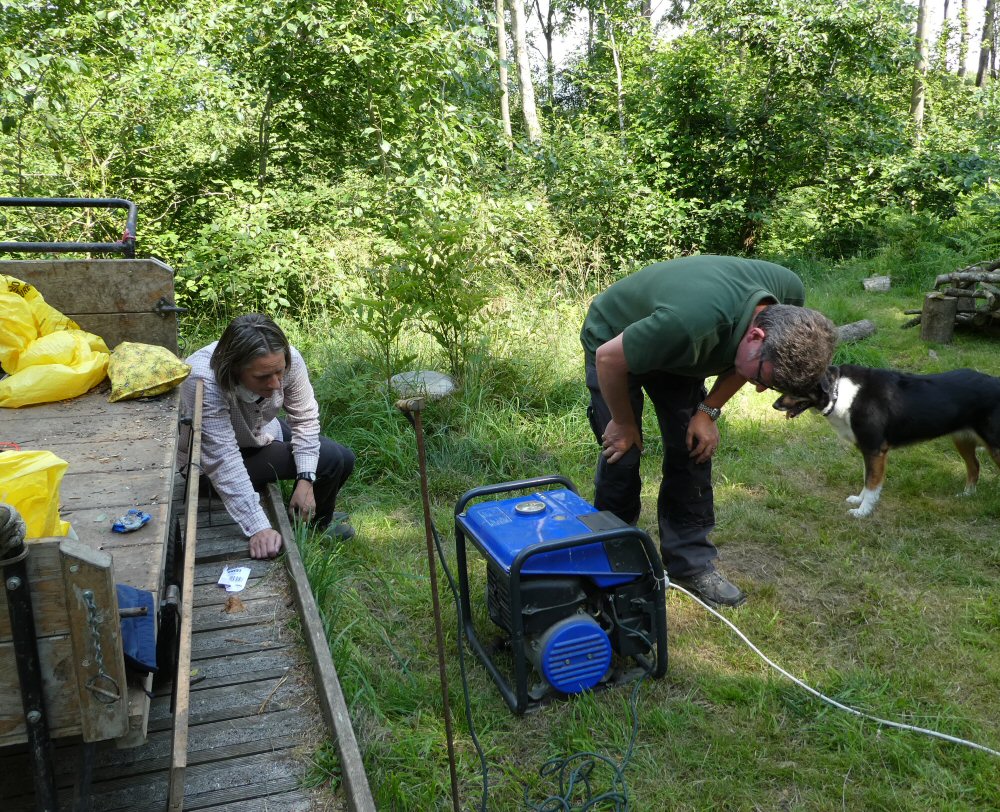
It was the normal moth morning and a Drinker moth was caught. One had not been seen for several years. More surprises in the morning?

Thank you to Sophie and Gerry for sorting the generators and helping to set up the moth traps. Thanks also to the moth group who also lent a hand.
A Variety of Different Species
Sunday, August 1st 2021
Walking through the Scrapes some light pink flowers come into view. This is Marsh Woundwort. It looks more attractive than its relative Hedge Woundwort which grows throughout the reserve, whereas Marsh Woundwort only grows in this small area of the Scrapes.
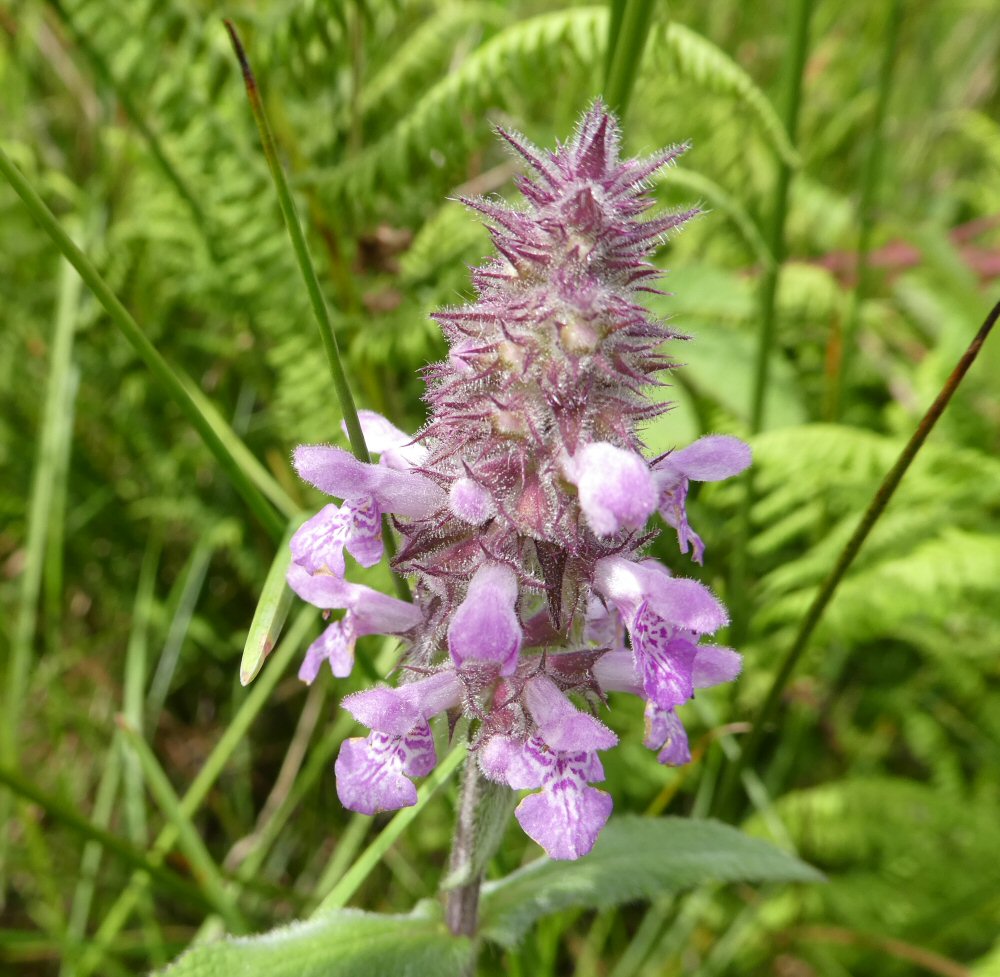
Looking carefully amongst vegetation there are some cone shaped webs and on closer inspection a spider can be seen hiding inside. Several stems of vegetation may be drawn together to help form a basis for the web.
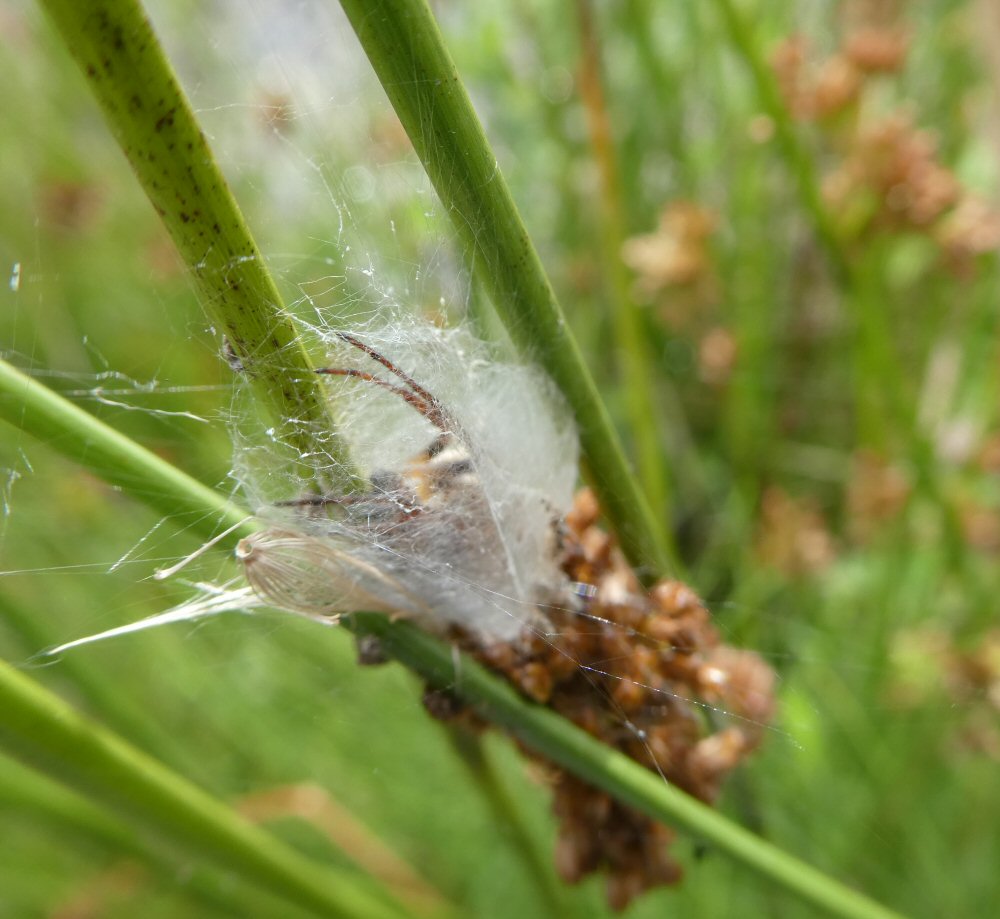
Water Figwort is not the most attractive of flowers, but Figwort Weevils like it. They look rather like bird droppings so can be easily overlooked.

Alder Tongue Gall,Taphrina alni is a fungal plant pathogen. This is a chemically induced distortion of female Alder catkins. The cone shows the beginning of the growth of the gall.
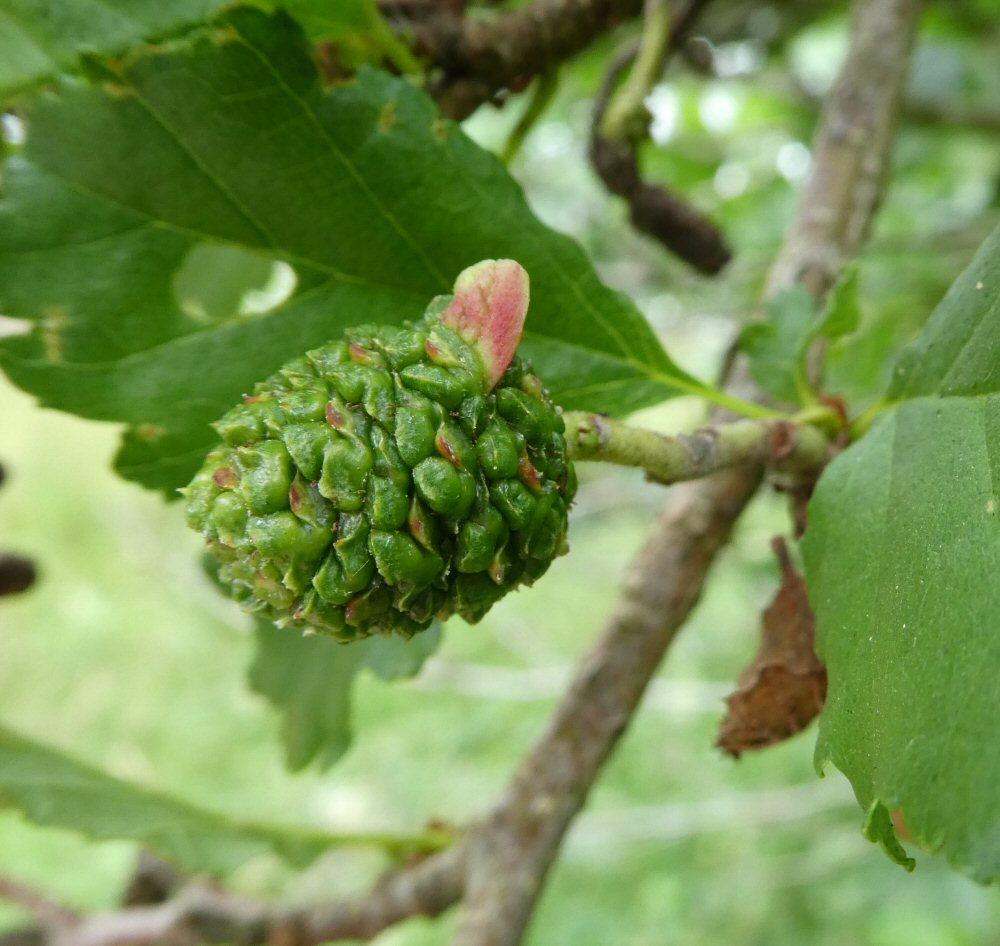
Another gall usually found on Norway and Sitka Spruce is the Pineapple Gall, Adelges abietis. This is caused by an insect. There are several developing insects inside the gall and they emerge from August. As this one is within easy reach we will see if we can observe the chambers later in the summer.
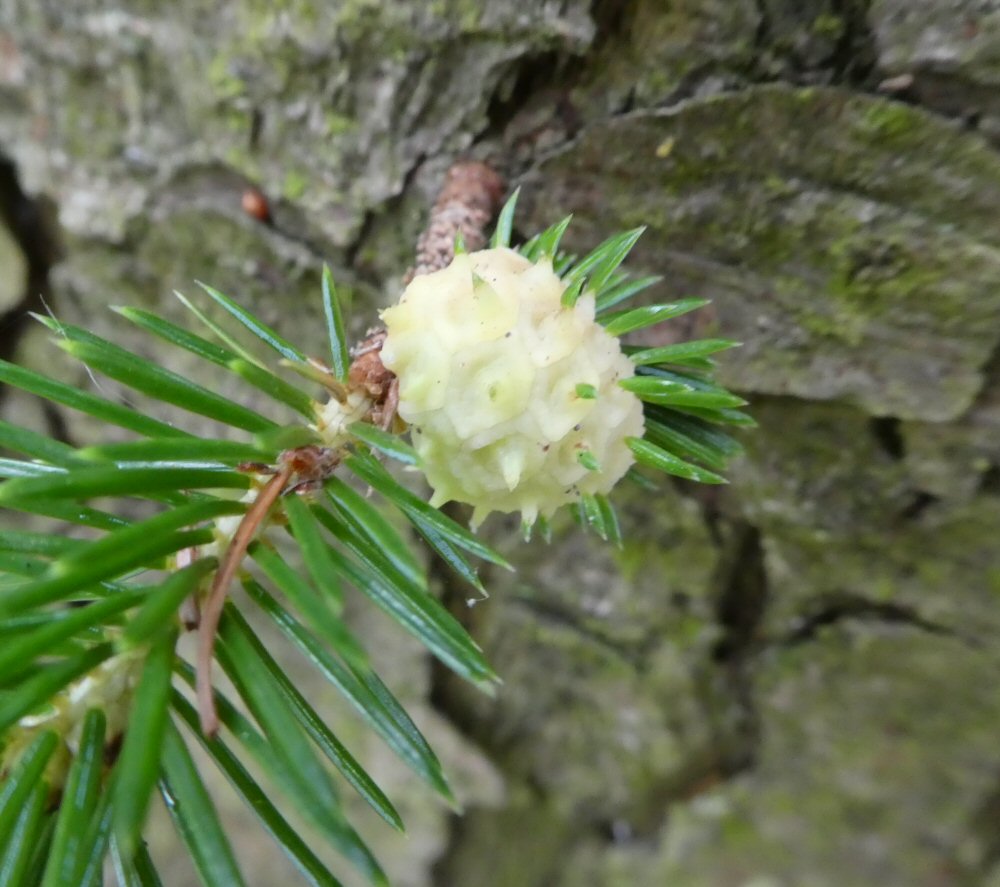
And finally, Andrew, caught this blue damsel resting comfortably on a soft feather.
.jpg)




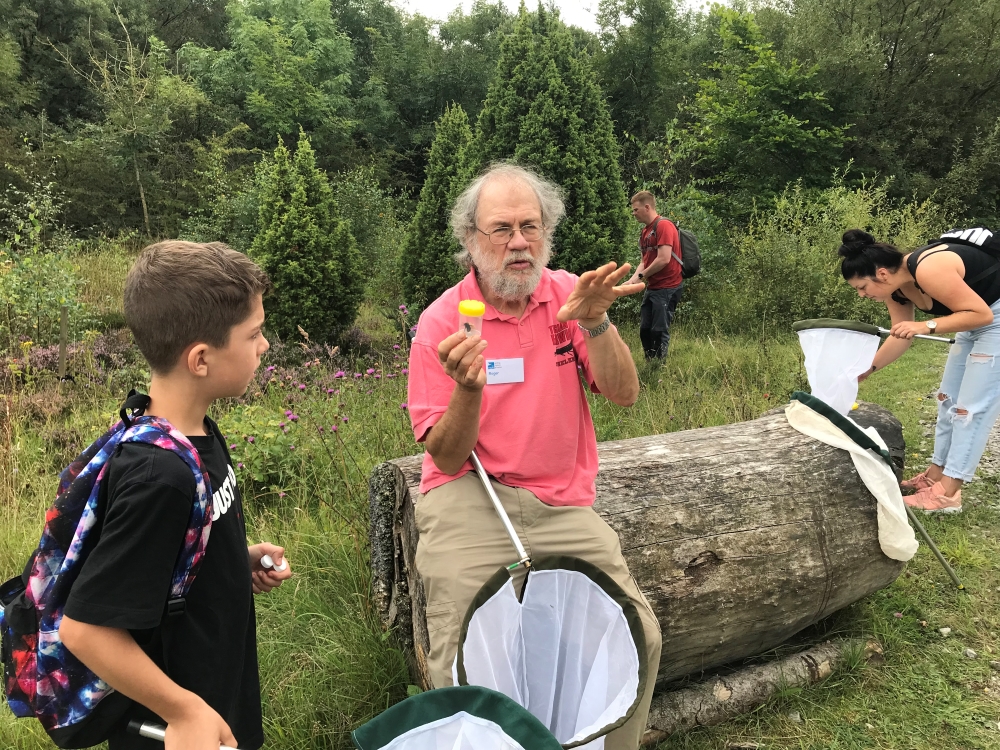

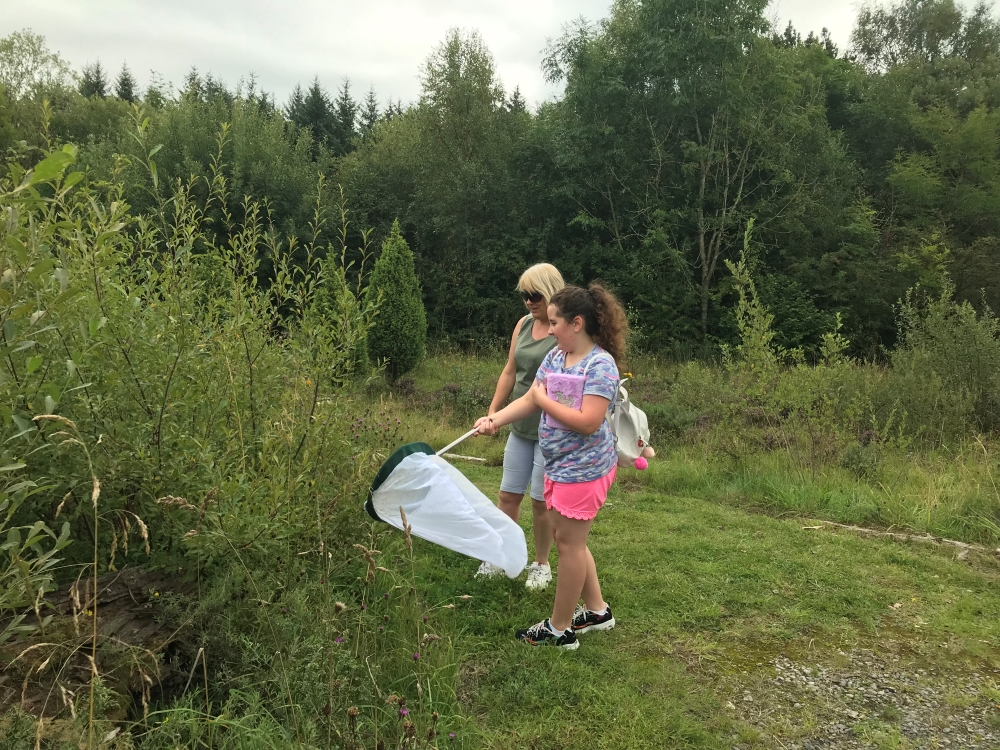
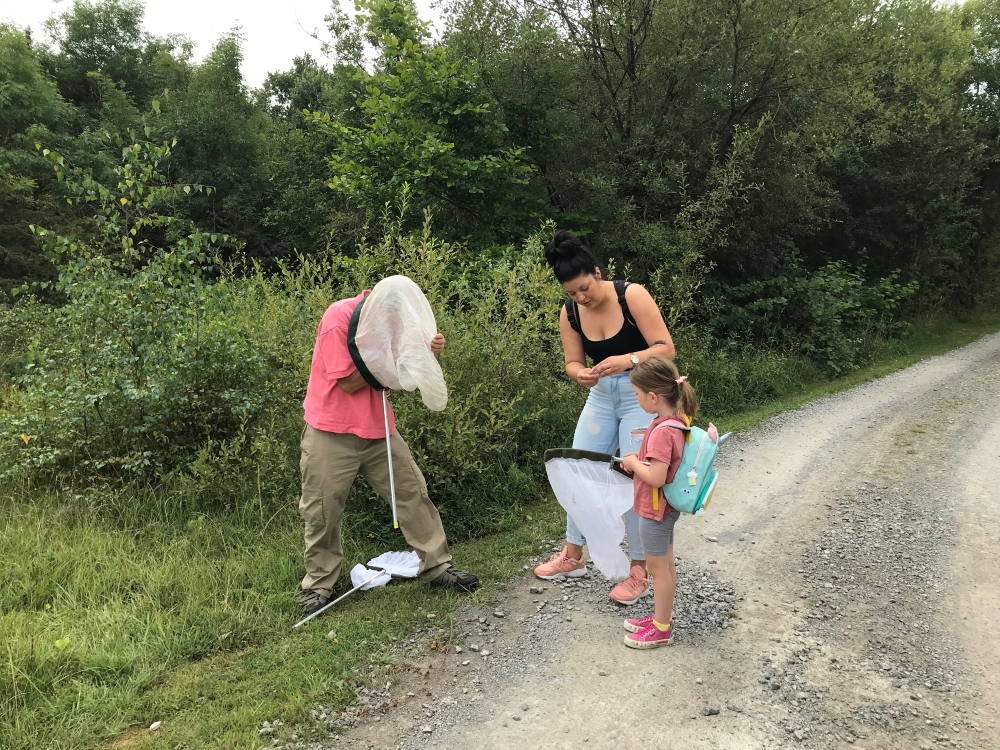

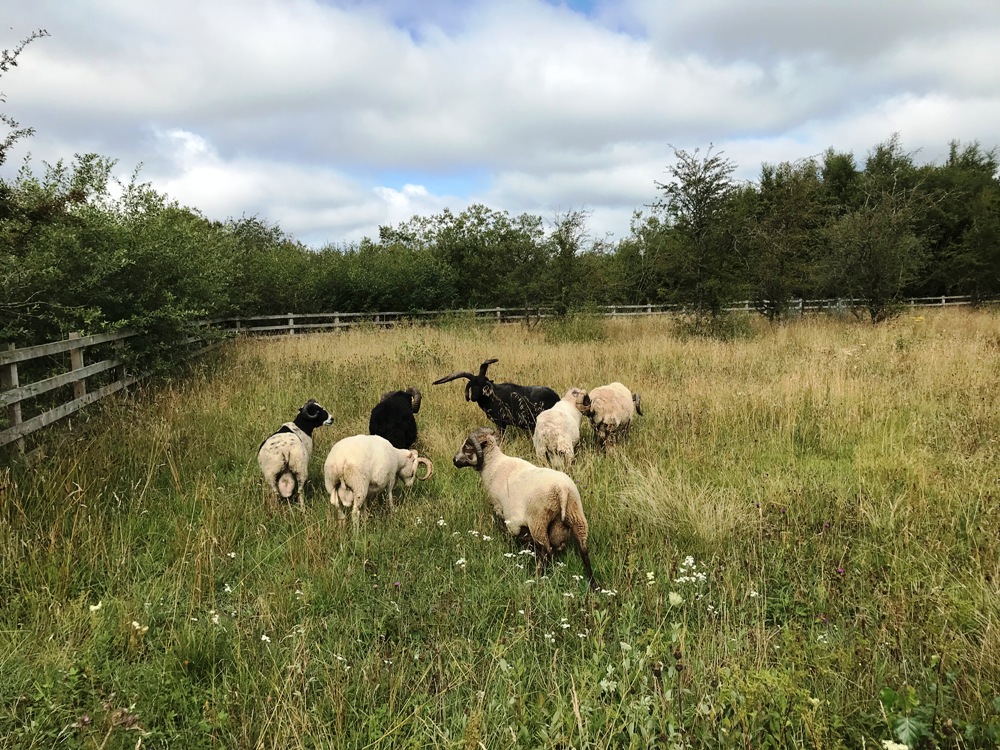
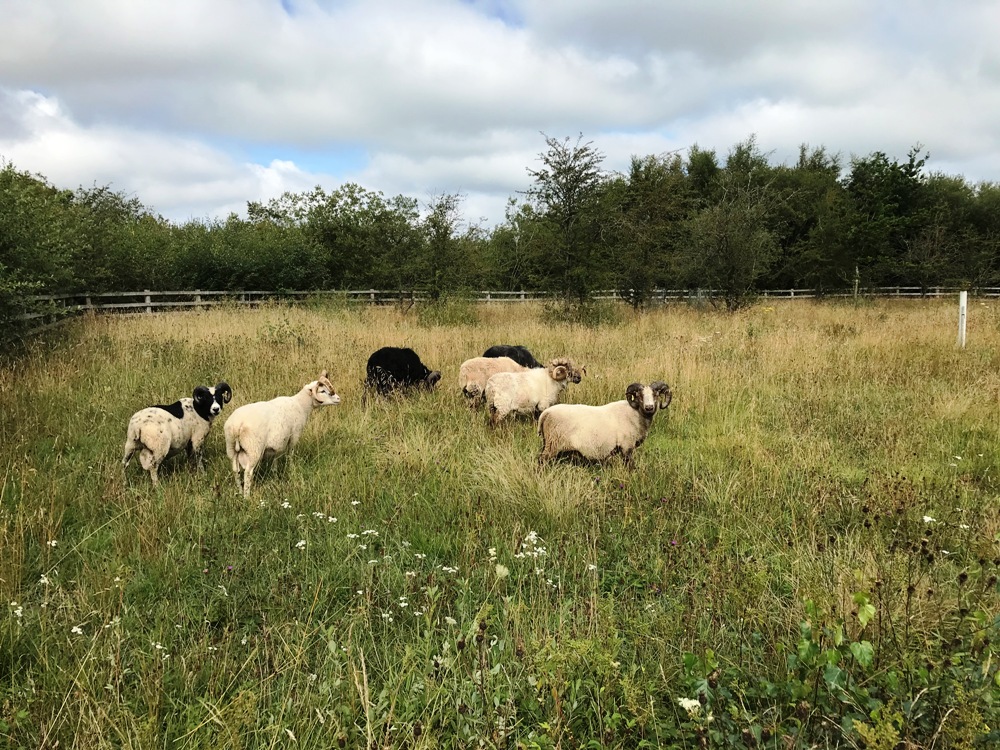
.JPG)

